-
 Shibuichi Kozuka carved in low relief (takabori, usuniku-bori) and inlaid in gold and silver with design of Shoko, reading by moonlight, thatch, pine rosettes, and fool moon. According to Henri L. Joly [LEGEND IN JAPANESE ART. London, 1908; LIB-1416 in this collection] Shoko was a Chinese student of Taoism who was so poor that he had no money to buy illuminating materials and read by moonlight. Shoko mentioned in the article about another Chinese character - Shaen, who was reading by the light emitted by glow-worms (see page 310). Signed on the back: Haruchika (春親) + kaō. Size: 97.3 mm (H) x 14.8 mm (W). Edo period, mid 19th century. NBTHK Certificate № 449542. Hamano Haruchika from Edo was a student of Haruyuki in 1848-54; Hamano School, Etchū Toyama Branch, according to M. Sesko's "Genealogy", page. 34. Most probably it is his work. Following the MFA data, it is also possible that "our" Haruchika is indeed Nara Haruchika or Tsuchiya Haruchika from Nara School; though I did not hind such artist in Markus Sesko books. However, in his "Toso-Kinko" on page 177 there is certain Shingorō who carried out his business under the name of Yanagawa Haruchika (1791-1857?)
Shibuichi Kozuka carved in low relief (takabori, usuniku-bori) and inlaid in gold and silver with design of Shoko, reading by moonlight, thatch, pine rosettes, and fool moon. According to Henri L. Joly [LEGEND IN JAPANESE ART. London, 1908; LIB-1416 in this collection] Shoko was a Chinese student of Taoism who was so poor that he had no money to buy illuminating materials and read by moonlight. Shoko mentioned in the article about another Chinese character - Shaen, who was reading by the light emitted by glow-worms (see page 310). Signed on the back: Haruchika (春親) + kaō. Size: 97.3 mm (H) x 14.8 mm (W). Edo period, mid 19th century. NBTHK Certificate № 449542. Hamano Haruchika from Edo was a student of Haruyuki in 1848-54; Hamano School, Etchū Toyama Branch, according to M. Sesko's "Genealogy", page. 34. Most probably it is his work. Following the MFA data, it is also possible that "our" Haruchika is indeed Nara Haruchika or Tsuchiya Haruchika from Nara School; though I did not hind such artist in Markus Sesko books. However, in his "Toso-Kinko" on page 177 there is certain Shingorō who carried out his business under the name of Yanagawa Haruchika (1791-1857?) -
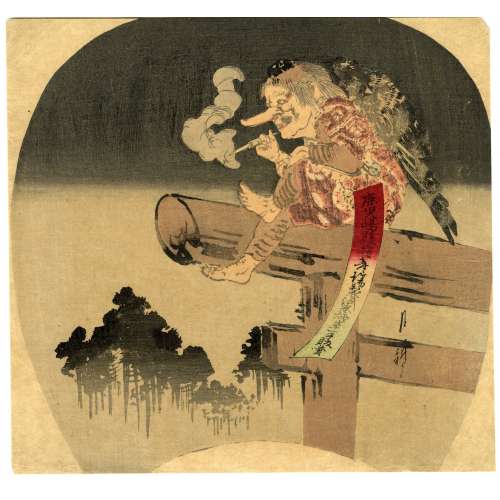 Ogata Gekkō [尾形月耕] (Japanese, 1859 – 1920). An uchiwa-e (fan-print) of advertisement of tobacco of Kagoshima Prefecture, c. 1890 (Meiji Period). Barefoot Tengu* is sitting on a torii (entrance to a Shinto shrine), smoking a cigarette through a mouthpiece. _______ * Tengu [天狗] (heavenly dog) is a type of legendary creature found in Japanese folk religion and are also considered a type of Shinto god (kami) or yōkai (supernatural beings).
Ogata Gekkō [尾形月耕] (Japanese, 1859 – 1920). An uchiwa-e (fan-print) of advertisement of tobacco of Kagoshima Prefecture, c. 1890 (Meiji Period). Barefoot Tengu* is sitting on a torii (entrance to a Shinto shrine), smoking a cigarette through a mouthpiece. _______ * Tengu [天狗] (heavenly dog) is a type of legendary creature found in Japanese folk religion and are also considered a type of Shinto god (kami) or yōkai (supernatural beings). -
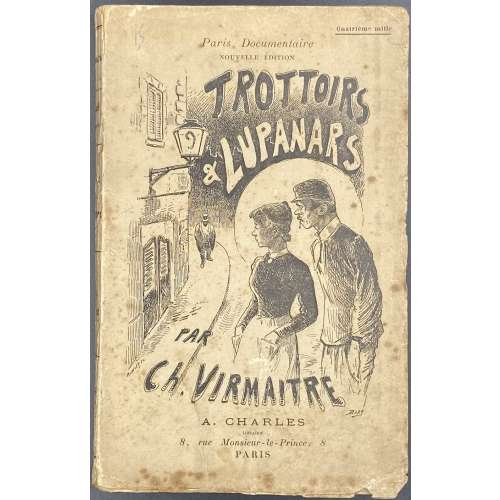 Front wrapper: Quatrième mille | Paris Documentaire | NOUVELLE ÉDITION | TROTTOIRS | ET | LUPANARS | PAR | Ch. VIRMAITRE | A. CHARLES | LIBRAIRE | 8, Rue Monsieur-le-Prince, 8 | PARIS || Title page: Ch. VIRMAITRE | PARIS DOCUMENTAIRE | (Mœurs) | TROTTOIRS | ET | LUPANARS | {fleuron} | A. CHARLES | LIBRAIRE | 8, Rue Monsieur-le-Prince, 8 | PARIS | 1897 || Collation: 18mo; Front pictorial wrapper, 2 ffls, π4, 118, 318, 518, 718, 918, 1118, 1318, 1514, back pictorial wrapper (portrait) Pagination: [1-7] 8-282 [6]. Binding: Publisher’s pictorial wrappers, lettering to spine. Charles Virmaître (French, 1835 – 1903).
Front wrapper: Quatrième mille | Paris Documentaire | NOUVELLE ÉDITION | TROTTOIRS | ET | LUPANARS | PAR | Ch. VIRMAITRE | A. CHARLES | LIBRAIRE | 8, Rue Monsieur-le-Prince, 8 | PARIS || Title page: Ch. VIRMAITRE | PARIS DOCUMENTAIRE | (Mœurs) | TROTTOIRS | ET | LUPANARS | {fleuron} | A. CHARLES | LIBRAIRE | 8, Rue Monsieur-le-Prince, 8 | PARIS | 1897 || Collation: 18mo; Front pictorial wrapper, 2 ffls, π4, 118, 318, 518, 718, 918, 1118, 1318, 1514, back pictorial wrapper (portrait) Pagination: [1-7] 8-282 [6]. Binding: Publisher’s pictorial wrappers, lettering to spine. Charles Virmaître (French, 1835 – 1903). -
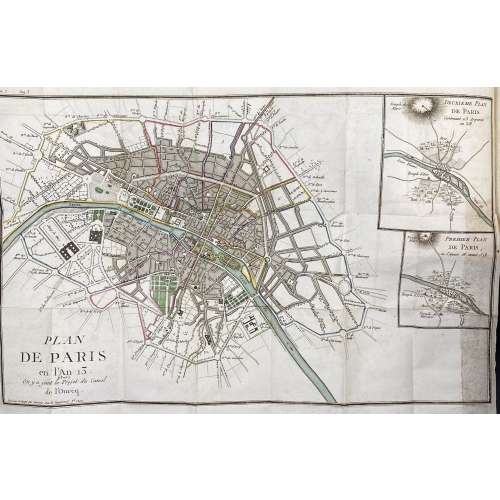 Two volumes, 12mo; 14 x 9 cm, uniformly bound in speckled calf with dentelle border in gilt, gilt-stamped spine with two crimson lettered labels, marbled endpapers. Inscription to h.t.: P. Leigh Smith | Moscow | 1921 || Vol. 1: Half-title: MIROIR | DE L'ANCIEN ET DU NOUVEAU | PARIS, | AVEC TREIZE VOYAGES | EN VÉLOCIFÈRES, |DANS SES ENVIRONS. | TOME I. || Title page: MIROIR | DE L'ANCIEN ET DU NOUVEAU | PARIS, | AVEC TREIZE VOYAGES | EN VÉLOCIFÈRES, |DANS SES ENVIRONS. Ouvrage indespensable aus Étrangers et même | aux Parisiens, et qui indique tout ce qu’il faut | connoître et éviter dans cette capitale. | Orné d’un Plan de Paris et de 18 Gravures | {to the right, in single rules} Tels temps, telles mœurs. | Par L. Prudhomme. | Tome I. | PARIS, | PRUDHOMME, fils, rue des Marais, F. B. St.-G. | DEBRAY, rue St. Honoré, barrière des Sergens. | AN XIII. — (1804.) || Pagination: [i-vii] viii-xxxvi, 1-260; total 296 pages + 15 copperplate engravings and 1 folding plan of Paris. Collation: πA-πC6, A-C6, 4-216 224; total 148 leaves + 15 plates + 1 folding. Note: 12mo; πA1 unsigned, A2 unsigned, A–C3 signed A-C5, respectively, 4* unsigned, 9* marked 8*, 18* marked 17*. Vol. 2: Similar half-title and title, TOME II instead of TOME I. Pagination: [4] 1-408; total 412 pages + 3 copperplate engravings. Collation: π2, 1-346; total 206 leaves + 3 plates.
Two volumes, 12mo; 14 x 9 cm, uniformly bound in speckled calf with dentelle border in gilt, gilt-stamped spine with two crimson lettered labels, marbled endpapers. Inscription to h.t.: P. Leigh Smith | Moscow | 1921 || Vol. 1: Half-title: MIROIR | DE L'ANCIEN ET DU NOUVEAU | PARIS, | AVEC TREIZE VOYAGES | EN VÉLOCIFÈRES, |DANS SES ENVIRONS. | TOME I. || Title page: MIROIR | DE L'ANCIEN ET DU NOUVEAU | PARIS, | AVEC TREIZE VOYAGES | EN VÉLOCIFÈRES, |DANS SES ENVIRONS. Ouvrage indespensable aus Étrangers et même | aux Parisiens, et qui indique tout ce qu’il faut | connoître et éviter dans cette capitale. | Orné d’un Plan de Paris et de 18 Gravures | {to the right, in single rules} Tels temps, telles mœurs. | Par L. Prudhomme. | Tome I. | PARIS, | PRUDHOMME, fils, rue des Marais, F. B. St.-G. | DEBRAY, rue St. Honoré, barrière des Sergens. | AN XIII. — (1804.) || Pagination: [i-vii] viii-xxxvi, 1-260; total 296 pages + 15 copperplate engravings and 1 folding plan of Paris. Collation: πA-πC6, A-C6, 4-216 224; total 148 leaves + 15 plates + 1 folding. Note: 12mo; πA1 unsigned, A2 unsigned, A–C3 signed A-C5, respectively, 4* unsigned, 9* marked 8*, 18* marked 17*. Vol. 2: Similar half-title and title, TOME II instead of TOME I. Pagination: [4] 1-408; total 412 pages + 3 copperplate engravings. Collation: π2, 1-346; total 206 leaves + 3 plates. -
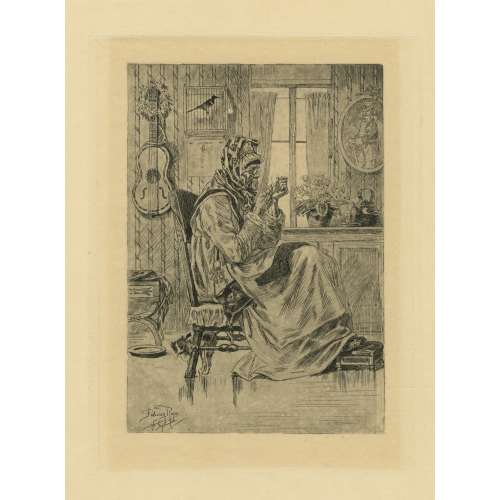
Etching on wove paper, depicting an old woman trying to thread a needle. Signed in plate: "Felicien Rops, 76 Septembre". Owner's stamp LvM on verso.
Dimensions: Paper: 51.9 x 35 cm; Plate: 27.5 x 21 cm; Image: 23.5 x 16 cm.
Catalogue raisonné: Arthur Hubschmid (1977): 358; Graphics irreverent and erotic (1968): 54.
-
 Artist: Utagawa Kuniyasu [歌川 国安] (Japanese, 1794–1832). Publisher seal: [太] (Ta): Marks 02-050 | U421b: An unknown publisher in Edo, fl. c. 1815-61; name assigned according to seal shape “Yama-Ta“. Signed: Kuniyasu ga [国安 画]. Date-aratame seal: Bunsei 9 (1826). Actors: Iwai Hanshirō VI [岩井半四郎] (Japanese, 1799 – 1836), other names: Iwai Hanshirō VI, Iwai Kumesaburō II, Iwai Hisajirō I, Baiga (poetry name), Shūka (poetry name) — as Shirai Gonpachi [白井權八]. Ichikawa Danjūrō VII 市川団十郎 (Japanese, 1791 – 1859), other names: Ichikawa Ebizō V, Ichikawa Hakuen II, Ichikawa Shinnosuke I — as Banzui Chōbei [幡随長兵衛]. Kabuki play: Suzugamori [Suzu-ga-Mori, 鈴ヶ森], a.k.a. Ukiyozuka Hiyoku no Inazuma written by Tsuruya Nanboku IV (Japanese, c. 1755 – 1829). First staged in 1823 at Ichimura-za [市村座] in Edo. Plot: "A gang of evil palanquin bearers are stationed near the Suzugamori execution grounds, where they lay in wait to rob travellers passing through. Gonpachi, who killed a man in his home province, is being sought by the police. He is fleeing to Edo when the bearers attack him in hopes of claiming a reward. He beats them off with great skill. Banzui Chōbei, who is being carried by in a palanquin, sees the attack, admires Gonpachi's ability, and promises to aid him if he is going to Edo". [Samuel L. Leiter. Historical Dictionary of Japanese Traditional Theatre. — Rowman & Littlefield, 2014; p. 382-3.; LIB-2110.2019]. Ref.: Sotheby's.
Artist: Utagawa Kuniyasu [歌川 国安] (Japanese, 1794–1832). Publisher seal: [太] (Ta): Marks 02-050 | U421b: An unknown publisher in Edo, fl. c. 1815-61; name assigned according to seal shape “Yama-Ta“. Signed: Kuniyasu ga [国安 画]. Date-aratame seal: Bunsei 9 (1826). Actors: Iwai Hanshirō VI [岩井半四郎] (Japanese, 1799 – 1836), other names: Iwai Hanshirō VI, Iwai Kumesaburō II, Iwai Hisajirō I, Baiga (poetry name), Shūka (poetry name) — as Shirai Gonpachi [白井權八]. Ichikawa Danjūrō VII 市川団十郎 (Japanese, 1791 – 1859), other names: Ichikawa Ebizō V, Ichikawa Hakuen II, Ichikawa Shinnosuke I — as Banzui Chōbei [幡随長兵衛]. Kabuki play: Suzugamori [Suzu-ga-Mori, 鈴ヶ森], a.k.a. Ukiyozuka Hiyoku no Inazuma written by Tsuruya Nanboku IV (Japanese, c. 1755 – 1829). First staged in 1823 at Ichimura-za [市村座] in Edo. Plot: "A gang of evil palanquin bearers are stationed near the Suzugamori execution grounds, where they lay in wait to rob travellers passing through. Gonpachi, who killed a man in his home province, is being sought by the police. He is fleeing to Edo when the bearers attack him in hopes of claiming a reward. He beats them off with great skill. Banzui Chōbei, who is being carried by in a palanquin, sees the attack, admires Gonpachi's ability, and promises to aid him if he is going to Edo". [Samuel L. Leiter. Historical Dictionary of Japanese Traditional Theatre. — Rowman & Littlefield, 2014; p. 382-3.; LIB-2110.2019]. Ref.: Sotheby's. -
 Artist: Utagawa Kunisada [歌川 国貞] a.k.a. Utagawa Toyokuni III [三代歌川豊国] (Japanese, 1786 – 1865). Signed: Ōju Toyokuni ga [応需豊国画] in a toshidama cartouche. Double nanushi censor seals Mera & Murata (1846-50). Publisher: Kojimaya Jūbei [小嶋屋重兵衛] (Japanese, fl. c. 1797 – 1869). A gentleman, probably a kabuki actor Nakamura Utaemon IV [中村歌右衛門] (Nakamura Shikan II, Nakamura Tsurusuke I, Nakamura Tōtarō, Japanese, 1796 – 1852) drinking tea on a veranda under the shining moon. Series Moon, Sun, Stars [月日星] (tsuki-hi-hoshi/boshi), the three sources of light (sankō) [三光]:
Artist: Utagawa Kunisada [歌川 国貞] a.k.a. Utagawa Toyokuni III [三代歌川豊国] (Japanese, 1786 – 1865). Signed: Ōju Toyokuni ga [応需豊国画] in a toshidama cartouche. Double nanushi censor seals Mera & Murata (1846-50). Publisher: Kojimaya Jūbei [小嶋屋重兵衛] (Japanese, fl. c. 1797 – 1869). A gentleman, probably a kabuki actor Nakamura Utaemon IV [中村歌右衛門] (Nakamura Shikan II, Nakamura Tsurusuke I, Nakamura Tōtarō, Japanese, 1796 – 1852) drinking tea on a veranda under the shining moon. Series Moon, Sun, Stars [月日星] (tsuki-hi-hoshi/boshi), the three sources of light (sankō) [三光]: -
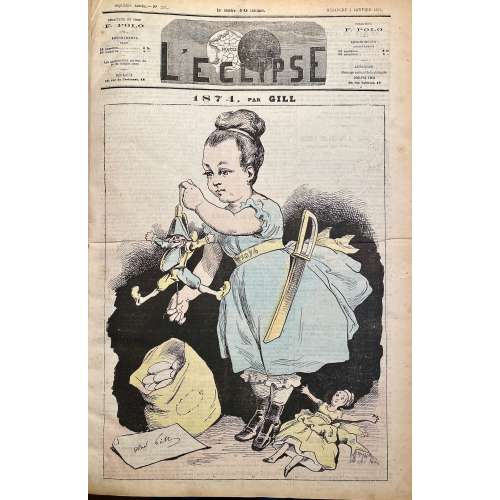 129 issues of L'Éclipse, French weekly political magazine; published in Paris, 49 x 34 cm, bound in rebacked green quarter morocco over marbled boards, with gilt fillets and lettering to spine, peacock marbled endpapers, illustrated by André Gill (French, 1840 – 1885). Founder and editor-in-chief François Polo (French, 1838 – 1874). 1874: 271-322 (52 issues) 1875: 323-374 (52 issues) 1876: 375-399 (25 issues)
129 issues of L'Éclipse, French weekly political magazine; published in Paris, 49 x 34 cm, bound in rebacked green quarter morocco over marbled boards, with gilt fillets and lettering to spine, peacock marbled endpapers, illustrated by André Gill (French, 1840 – 1885). Founder and editor-in-chief François Polo (French, 1838 – 1874). 1874: 271-322 (52 issues) 1875: 323-374 (52 issues) 1876: 375-399 (25 issues) -
 Artist: Utagawa Kuniyoshi [歌川 國芳] (1798 – 1861). A beauty leaning on a fence and watching a dragonfly hovering above a flowering plant. Signed: Ichiyûsai Kuniyoshi ga (一勇斎 國芳 画) in a double gourd-shaped red cartouche. Publisher: Maruya Jinpachi, seal Jin [甚] (Marks 08-088 | 294d). No date/censor seal. Media: Fan print (uchiwa-e, 団扇絵), 234 x 301 mm.
Artist: Utagawa Kuniyoshi [歌川 國芳] (1798 – 1861). A beauty leaning on a fence and watching a dragonfly hovering above a flowering plant. Signed: Ichiyûsai Kuniyoshi ga (一勇斎 國芳 画) in a double gourd-shaped red cartouche. Publisher: Maruya Jinpachi, seal Jin [甚] (Marks 08-088 | 294d). No date/censor seal. Media: Fan print (uchiwa-e, 団扇絵), 234 x 301 mm. -
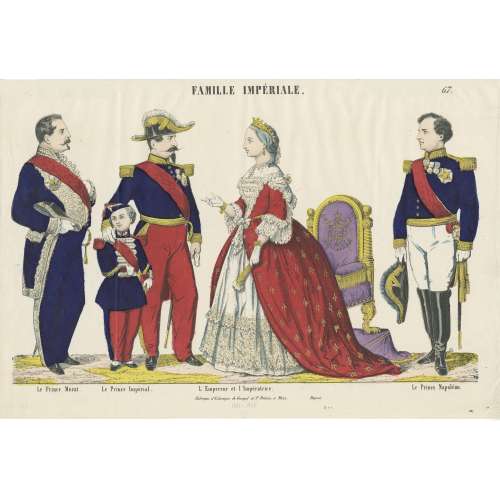 Hand-coloured woodcut on wove paper, 288 x 426 mm; black ink stamp “5305” to reverse. Top centre: "FAMILLE IMPÉRIALE", right: "67." Under the image: "Le Prince Murat." — "Le Prince Impérial." — "L' Empereur et l'Impératrice." — "Le Prince Napoléon." Bottom: "Fabrique d'Estampes de Gangel et P. Didion, à Metz." — "Déposé." Bottom: ms in pencil "1861 – 1868". Publisher/printer: Gangel et P. Didion (Metz); Paulin Didion (French, 1831 – 1879). Characters: Napoleon III [Charles-Louis Napoléon Bonaparte] (French, 1808 – 1873) Eugénie de Montijo [L'impératrice Eugénie] (Spanish-French, 1826 – 1920) Napoléon, Prince Imperial (Napoléon Eugène Louis Jean Joseph Bonaparte] (French, 1856 – 1879) Prince Murat [Lucien Charles Joseph Napoléon] (French, 1803 – 1878) Napoléon-Jérôme Bonaparte [Prince Napoléon] (French, 1822 – 1891)
Hand-coloured woodcut on wove paper, 288 x 426 mm; black ink stamp “5305” to reverse. Top centre: "FAMILLE IMPÉRIALE", right: "67." Under the image: "Le Prince Murat." — "Le Prince Impérial." — "L' Empereur et l'Impératrice." — "Le Prince Napoléon." Bottom: "Fabrique d'Estampes de Gangel et P. Didion, à Metz." — "Déposé." Bottom: ms in pencil "1861 – 1868". Publisher/printer: Gangel et P. Didion (Metz); Paulin Didion (French, 1831 – 1879). Characters: Napoleon III [Charles-Louis Napoléon Bonaparte] (French, 1808 – 1873) Eugénie de Montijo [L'impératrice Eugénie] (Spanish-French, 1826 – 1920) Napoléon, Prince Imperial (Napoléon Eugène Louis Jean Joseph Bonaparte] (French, 1856 – 1879) Prince Murat [Lucien Charles Joseph Napoléon] (French, 1803 – 1878) Napoléon-Jérôme Bonaparte [Prince Napoléon] (French, 1822 – 1891) -

Fuchi-kashira made of shakudō carved and inlaid with gold and red copper with the design of a bat and a fruit (persimmon?). Nanako surface.
Fuchi: 37 x 19 x 7 mm. Kashira: 34 x 16 x 5 mm. Main material: shakudō. Other metals: gold and copper. Surface treatment: nanako-ji. -
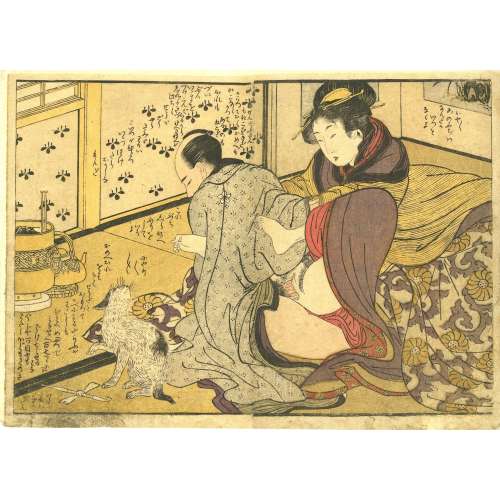 Kitagawa Utamaro. According to Chris Uhlenberg this is an illustration from the book Ehon koi no Onamaki, 3 vols, published in Kansei 11 (1799). Illustrated in b/w in: Hayashi Yoshikazu: Kitagawa Utamaro, in the series: Edo makura-e shi shusei, published in 1990, reissued 1994. Size: Chuban (25.5 x 18.5 cm), two book pages glued together.
Kitagawa Utamaro. According to Chris Uhlenberg this is an illustration from the book Ehon koi no Onamaki, 3 vols, published in Kansei 11 (1799). Illustrated in b/w in: Hayashi Yoshikazu: Kitagawa Utamaro, in the series: Edo makura-e shi shusei, published in 1990, reissued 1994. Size: Chuban (25.5 x 18.5 cm), two book pages glued together. -
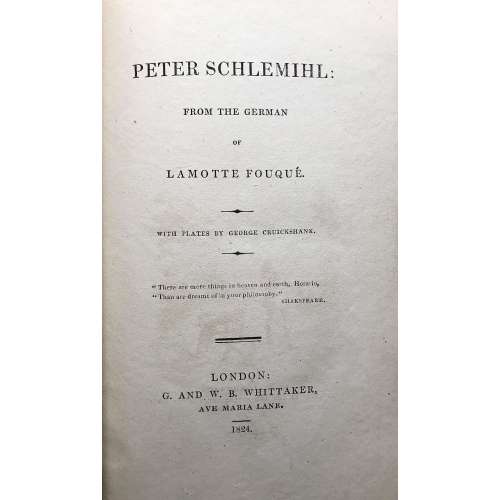 Title: PETER SCHLEMIHL: | FROM THE GERMAN | OF LAMOTTE FOUQUÉ | WITH PLATES BY GEORGE CRUICKSHANK. | "There are more things in heaven and earth, Horatio, | "Than are dreamt of in your philosophy." | SHAKESPEARE. | — | LONDON: | G. AND W. B. WHITTAKER, | AVE MARIA LANE. | 1824.|| Pagination: xii, 165 p. : ill. No Adelbert von Chamisso (German, 1781 – 1838) name on the title page. George Cruikshank's name printed with a typo 'Cruickshank'. The attribution on the title-page to Friedrich de La Motte-Fouqué (German, 1777 – 1843) is erroneous. The original German was edited by La Motte Fouqué. The translation was performed by Sir John Bowring (British, 1792 – 1872) First edition in English, third issue with no hyphen between "Ave" and 'Maria" in publisher's imprint.
Title: PETER SCHLEMIHL: | FROM THE GERMAN | OF LAMOTTE FOUQUÉ | WITH PLATES BY GEORGE CRUICKSHANK. | "There are more things in heaven and earth, Horatio, | "Than are dreamt of in your philosophy." | SHAKESPEARE. | — | LONDON: | G. AND W. B. WHITTAKER, | AVE MARIA LANE. | 1824.|| Pagination: xii, 165 p. : ill. No Adelbert von Chamisso (German, 1781 – 1838) name on the title page. George Cruikshank's name printed with a typo 'Cruickshank'. The attribution on the title-page to Friedrich de La Motte-Fouqué (German, 1777 – 1843) is erroneous. The original German was edited by La Motte Fouqué. The translation was performed by Sir John Bowring (British, 1792 – 1872) First edition in English, third issue with no hyphen between "Ave" and 'Maria" in publisher's imprint.In a cover box of red cloth over cardboard. Box: 21 x 13 x 2.3 cm; book: 19.3 x 11.8 x 1.7 cm; Crown 8vo. Red cardboard binding. Printed spine labels mounted on spine of the box and the book. Untrimmed edges.
Reference: Cohn 475. -
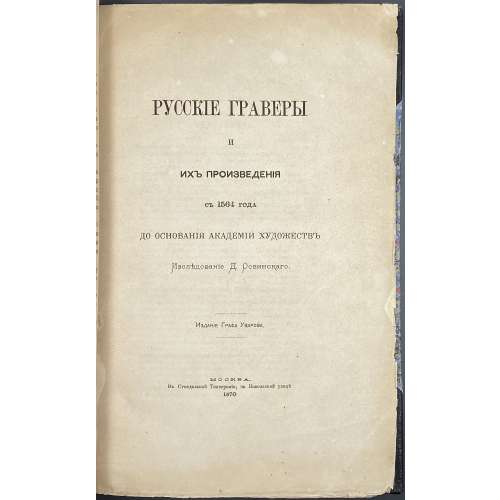 Title: РУССКIЕ ГРАВЕРЫ | И | ИХЪ ПРОИЗВЕДЕНIЯ | СЪ 1564 ГОДА | ДО ОСНОВАНIЯ АКАДЕМIИ ХУДОЖЕСТВЪ. | Изследованiе Д. Ровинскаго. | Изданiе графа Уварова. | МОСКВА. | Въ Сѵнодальной типографiи, на Никольской улицѣ. | 1870. || Pagination: [2] orig. wrapper / advert., [2] t.p. / imp.[i] ii-x, [1] 2-403 [404], [2] orig. wrapper / advert. Collation: 8vo; π6 (incl. t.p.), 1-258 χ2 Binding: Owner’s ½ black morocco over marbled boards, raised bands, gilt-ruled, florets and lettering in compartments, blue endpapers, uncut, untrimmed, original wrappers preserved. Size: 29.5 x 19 cm
Title: РУССКIЕ ГРАВЕРЫ | И | ИХЪ ПРОИЗВЕДЕНIЯ | СЪ 1564 ГОДА | ДО ОСНОВАНIЯ АКАДЕМIИ ХУДОЖЕСТВЪ. | Изследованiе Д. Ровинскаго. | Изданiе графа Уварова. | МОСКВА. | Въ Сѵнодальной типографiи, на Никольской улицѣ. | 1870. || Pagination: [2] orig. wrapper / advert., [2] t.p. / imp.[i] ii-x, [1] 2-403 [404], [2] orig. wrapper / advert. Collation: 8vo; π6 (incl. t.p.), 1-258 χ2 Binding: Owner’s ½ black morocco over marbled boards, raised bands, gilt-ruled, florets and lettering in compartments, blue endpapers, uncut, untrimmed, original wrappers preserved. Size: 29.5 x 19 cm -
![Auguste Vitu. Les réunions publiques à Paris 1868-1869. — Paris: E. Dentu, 1869. — pp.: [1-5] 6-151 [1].](https://varshavskycollection.com/wp-content/uploads/2021/02/LIB-2432.2020-a-500x500.jpeg) Cover: LES | RÉUNIONS PUBLIQUES | A PARIS | 1868 — 1869 | PAR | AUGUSTE VITU | TROISIÈME ÉDITION | Augmentée d’un Appendice contenant les Jugements et Arrêts | rendus à Paris en matière de réunions publiques | PARIS | E. DENTU, LIBRAIRE-ÉDITEUR | PALAIS-ROYAL, 17-19, GALERIE D’ORLÉANS | MAI 1869 || ; t.p. similar with no dash between 17 and 19 in the bottom. Pagination: [1-5] 6-151 [1]; collation: 8vo, [1]8 2-98 103; 23 x 14 cm, publisher’s lettered blue paper wrappers. Printer: Dubuisson et Cie (Paris). Vitu, Auguste-Charles-Joseph (French, 1823 – 1891)
Cover: LES | RÉUNIONS PUBLIQUES | A PARIS | 1868 — 1869 | PAR | AUGUSTE VITU | TROISIÈME ÉDITION | Augmentée d’un Appendice contenant les Jugements et Arrêts | rendus à Paris en matière de réunions publiques | PARIS | E. DENTU, LIBRAIRE-ÉDITEUR | PALAIS-ROYAL, 17-19, GALERIE D’ORLÉANS | MAI 1869 || ; t.p. similar with no dash between 17 and 19 in the bottom. Pagination: [1-5] 6-151 [1]; collation: 8vo, [1]8 2-98 103; 23 x 14 cm, publisher’s lettered blue paper wrappers. Printer: Dubuisson et Cie (Paris). Vitu, Auguste-Charles-Joseph (French, 1823 – 1891) -
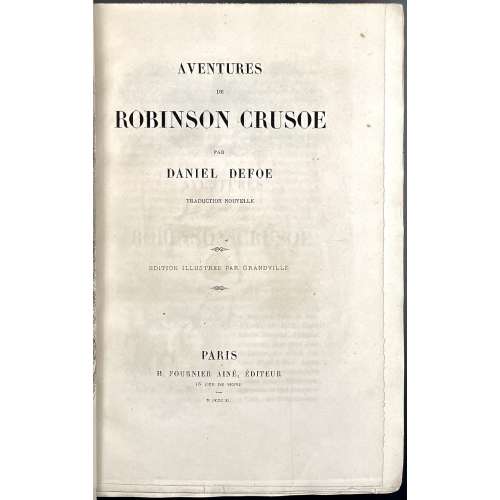 Title page: AVENTURES | DE | ROBINSON CRUSOE | PAR | DANIEL DEFOE | TRADUCTION NOUVELLE | ☙ |EDITION ILLUSTREE PAR GRANDVILLE | ❧ |PARIS | H. FOURNIER AINÉ, ÉDITEUR | 16 RUE DE SEINE | — | M DCCC XL || {sic: no accents in EDITION ILLUSTREE) Pagination: [4] [1]-610, [2] [1]-4., 620 pp. total plus 82 leaves of plates, unpaginated. Collation: 2 binder’s blank leaves, front publisher’s wrapper, h.t / imprint, 2 copies of engraved frontispiece on china paper, t.p. / blank, etc., … text..., back wrapper and spine bound in; 4to: π2 [1]-774 (310 leaves total) plus 40 x 2 plates extraneous to collation. Illustrations: 2 head- and 2 tailpieces, 2 initials, 159 vignettes, and 40 lettered plates each in two variants: one printed on a regular page, and one printed on India paper and pasted to a page. Page size: 24 x 15 cm. Frontispiece: Cut on wood by Louis-Henri Brevière after J. J. Grandville and Français. “Robinson sits on a throne-like chair framed by exotic palm trees. The sculptural and quasi-royal representation of Robinson is flanked by his faithful dog and parrot. The hero’s tools (the gun and the axe) are prominently displayed. He looks to the horizon away to the left, rather than to the tiny ship that can be seen on the horizon. His overcoming of life’s difficult events is at the core of the representation. The massive plinth reinforces the aura of the hero, as do the tiny people admiring the sculpture and learning about the heroic figure. Friday is discreetly represented in a medallion on the plinth along with other decorations including goats and a «savage»". [Sitzia, E. (2020). Lost in Intersemiotic Translation? J.J. Grandville’s Illustration of Robinson Crusoe. Journal for Literary and Intermedial Crossings, 5(2). https://clic.research.vub.be/sites/default/files/atoms/files/SITZIA_FIN.pdf] The monument has an inscription: “ FERNAND | SUEZ” which we deciphered as either a tribute to Juan Fernández (Spanish, c. 1536 – c. 1604) or as a mention of the place where Crusoe’s adventures took place: Archipiélago Juan Fernández to which Isla Róbinson Crusoe belongs. Binding: 24.8 x 16.4 cm, by Emile Mercier, half green crushed morocco over marbled boards, gilt-ruled, spine ornately gilt, sunned to orange tone, marbled endpapers, publisher's pale yellow wrappers bound in; only the top edge trimmed. Contributors: Daniel Defoe (British, 1660 – 1731) – author. J. J. Grandville [Gèrard, Isidore-Adolphe] (French, 1803 – 1847) – artist. François-Louis Français (French, 1814 – 1897) – artist (frontispiece, landscapes). Engravers: John Quartley (British, fl. 1835 – 1867) Matthew Urlwin Sears (British, 1799 – 1870) Adolphe Best (French, 1808 – 1860) One of the Guillaumots: Eugène Guillaumot (French, Paris 1813–1869), or Auguste Etienne Guillaumot (French,1844 – 1890), or his father Auguste-Alexandre Guillaumot (French, 1815 – 1892) Laisné [Alfred, Adèle, and Aglaé] (French, active 1835–1868) Antoine-Alphée Piaud (French, 1813 – 1867) Louis Dujardin (French, 1808 – 1859) A. Hans (nothing is known) Jean Louis Joseph Camille Lacoste (French, 1809 – 1866) Louis-Henri Brevière (French, 1797 – 1869) – vignettes. Provenance: Bishop, Cortlandt Field (American, 1870 – 1935) – bookplate; Mary S. Collins – bookplate by J. H. Fincken Robin F. Satinsky (American, 1919 – 2008) – Robin Collection bookplate. Catalogue raisonné: Brivois (1883) p. 155; Ray (French): № 193, p. 272; Carteret (1927): p. 241. All indicated in-8vo, which doesn't correspond to our in-4to copy.
Title page: AVENTURES | DE | ROBINSON CRUSOE | PAR | DANIEL DEFOE | TRADUCTION NOUVELLE | ☙ |EDITION ILLUSTREE PAR GRANDVILLE | ❧ |PARIS | H. FOURNIER AINÉ, ÉDITEUR | 16 RUE DE SEINE | — | M DCCC XL || {sic: no accents in EDITION ILLUSTREE) Pagination: [4] [1]-610, [2] [1]-4., 620 pp. total plus 82 leaves of plates, unpaginated. Collation: 2 binder’s blank leaves, front publisher’s wrapper, h.t / imprint, 2 copies of engraved frontispiece on china paper, t.p. / blank, etc., … text..., back wrapper and spine bound in; 4to: π2 [1]-774 (310 leaves total) plus 40 x 2 plates extraneous to collation. Illustrations: 2 head- and 2 tailpieces, 2 initials, 159 vignettes, and 40 lettered plates each in two variants: one printed on a regular page, and one printed on India paper and pasted to a page. Page size: 24 x 15 cm. Frontispiece: Cut on wood by Louis-Henri Brevière after J. J. Grandville and Français. “Robinson sits on a throne-like chair framed by exotic palm trees. The sculptural and quasi-royal representation of Robinson is flanked by his faithful dog and parrot. The hero’s tools (the gun and the axe) are prominently displayed. He looks to the horizon away to the left, rather than to the tiny ship that can be seen on the horizon. His overcoming of life’s difficult events is at the core of the representation. The massive plinth reinforces the aura of the hero, as do the tiny people admiring the sculpture and learning about the heroic figure. Friday is discreetly represented in a medallion on the plinth along with other decorations including goats and a «savage»". [Sitzia, E. (2020). Lost in Intersemiotic Translation? J.J. Grandville’s Illustration of Robinson Crusoe. Journal for Literary and Intermedial Crossings, 5(2). https://clic.research.vub.be/sites/default/files/atoms/files/SITZIA_FIN.pdf] The monument has an inscription: “ FERNAND | SUEZ” which we deciphered as either a tribute to Juan Fernández (Spanish, c. 1536 – c. 1604) or as a mention of the place where Crusoe’s adventures took place: Archipiélago Juan Fernández to which Isla Róbinson Crusoe belongs. Binding: 24.8 x 16.4 cm, by Emile Mercier, half green crushed morocco over marbled boards, gilt-ruled, spine ornately gilt, sunned to orange tone, marbled endpapers, publisher's pale yellow wrappers bound in; only the top edge trimmed. Contributors: Daniel Defoe (British, 1660 – 1731) – author. J. J. Grandville [Gèrard, Isidore-Adolphe] (French, 1803 – 1847) – artist. François-Louis Français (French, 1814 – 1897) – artist (frontispiece, landscapes). Engravers: John Quartley (British, fl. 1835 – 1867) Matthew Urlwin Sears (British, 1799 – 1870) Adolphe Best (French, 1808 – 1860) One of the Guillaumots: Eugène Guillaumot (French, Paris 1813–1869), or Auguste Etienne Guillaumot (French,1844 – 1890), or his father Auguste-Alexandre Guillaumot (French, 1815 – 1892) Laisné [Alfred, Adèle, and Aglaé] (French, active 1835–1868) Antoine-Alphée Piaud (French, 1813 – 1867) Louis Dujardin (French, 1808 – 1859) A. Hans (nothing is known) Jean Louis Joseph Camille Lacoste (French, 1809 – 1866) Louis-Henri Brevière (French, 1797 – 1869) – vignettes. Provenance: Bishop, Cortlandt Field (American, 1870 – 1935) – bookplate; Mary S. Collins – bookplate by J. H. Fincken Robin F. Satinsky (American, 1919 – 2008) – Robin Collection bookplate. Catalogue raisonné: Brivois (1883) p. 155; Ray (French): № 193, p. 272; Carteret (1927): p. 241. All indicated in-8vo, which doesn't correspond to our in-4to copy. -
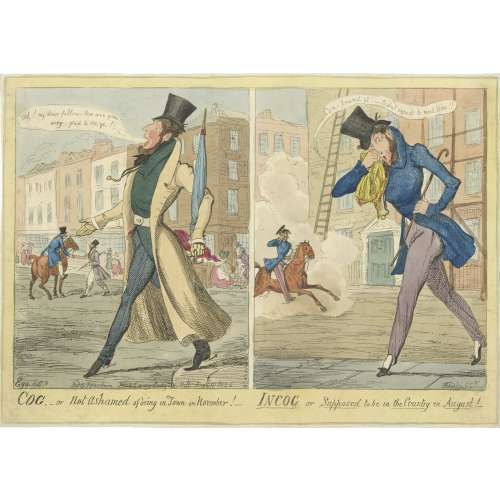 Description by British Museum (1865,1111.2128): "Two designs, side by side. [1] A dandy (probably a portrait), florid, whiskered, and bearded, steps jauntily from the pavement, hand extended, saying: Ah! my dear fellow — How are you? Devilish glad to see ye!— He holds a closed umbrella, ferrule erect, and wears a long tight-waisted coat to the heels, unbuttoned, tight pantaloons and spurred boots. In the middle distance, another dandy grasps the hand of a friend on horseback. Behind are houses with shop-fronts. A man raises his hat to a lady who curtseys. [2] The same dandy steps from the roadway onto the pavement, his handkerchief to his nose; he stoops, trying to conceal himself from a dandy cantering past in a cloud of dust, his eye-glass to his eye. He is without gloves, extraordinary for a dandy, and his trousers are strapped over pumps; he says: Con-found it! — Didn't expect to meet Him!! The street is otherwise empty; against the (large) houses are scaffolding and a tall ladder." Lettered with title, text within image including production details: 'Ego. delt / Etched by G. Ck / Pubd by J Fairburn Broadway Ludgate Hill August 18 1826'. Dimensions: Sheet: 25.5 x 36 cm, Image: 21.7 x 33.8 cm. Catalogue raisonné: A. M. Cohn (1924): № 1001, p. 262.: "A wretched plate. Difficult to believe G. C. had anything to do with it." — Bruton. Value.— £1.
Description by British Museum (1865,1111.2128): "Two designs, side by side. [1] A dandy (probably a portrait), florid, whiskered, and bearded, steps jauntily from the pavement, hand extended, saying: Ah! my dear fellow — How are you? Devilish glad to see ye!— He holds a closed umbrella, ferrule erect, and wears a long tight-waisted coat to the heels, unbuttoned, tight pantaloons and spurred boots. In the middle distance, another dandy grasps the hand of a friend on horseback. Behind are houses with shop-fronts. A man raises his hat to a lady who curtseys. [2] The same dandy steps from the roadway onto the pavement, his handkerchief to his nose; he stoops, trying to conceal himself from a dandy cantering past in a cloud of dust, his eye-glass to his eye. He is without gloves, extraordinary for a dandy, and his trousers are strapped over pumps; he says: Con-found it! — Didn't expect to meet Him!! The street is otherwise empty; against the (large) houses are scaffolding and a tall ladder." Lettered with title, text within image including production details: 'Ego. delt / Etched by G. Ck / Pubd by J Fairburn Broadway Ludgate Hill August 18 1826'. Dimensions: Sheet: 25.5 x 36 cm, Image: 21.7 x 33.8 cm. Catalogue raisonné: A. M. Cohn (1924): № 1001, p. 262.: "A wretched plate. Difficult to believe G. C. had anything to do with it." — Bruton. Value.— £1. -
 Title: Seventh lunar month [初秋] (Hatsuaki no zu); Series: Fashionable Twelve Months (Imayo juni-kagetsu). Another version of translation: Modern Beauties of Twelve Months. Artist: Utagawa Toyokuni I [歌川豊国] (1769–1825). Pubisher: Ibaya Senzaburō [伊場屋仙三郎] (Japanese, 1815 – 1869), seal: Dansendō [伊場仙]. Signed: Toyokuni ga and sealed with toshidama. Date-kiwame seal: Ushi (ox), Bunsei 5 (1822). Size: double-sheet uncut fan print ( aiban uchiwa-e), 219 x 295 mm.
Title: Seventh lunar month [初秋] (Hatsuaki no zu); Series: Fashionable Twelve Months (Imayo juni-kagetsu). Another version of translation: Modern Beauties of Twelve Months. Artist: Utagawa Toyokuni I [歌川豊国] (1769–1825). Pubisher: Ibaya Senzaburō [伊場屋仙三郎] (Japanese, 1815 – 1869), seal: Dansendō [伊場仙]. Signed: Toyokuni ga and sealed with toshidama. Date-kiwame seal: Ushi (ox), Bunsei 5 (1822). Size: double-sheet uncut fan print ( aiban uchiwa-e), 219 x 295 mm.

-
 Artist: Utagawa Kunisada [歌川 国貞] a.k.a. Utagawa Toyokuni III [三代歌川豊国] (Japanese, 1786 – 1865). Signed: Ichiyōsai Toyokuni hitsu [一陽斎豊国筆]. Inscriptions: [松竹梅] Shochikubai = pine (matsu, 松), bamboo (take, 竹), and plum (ume, 梅) – an auspicious grouping known as "The Three Friends of Winter"; [三福追] (Sanpuku tsui) – the three delights, or pleasures. Date seal and aratame censor seal: Ansei 2, 1st month (1855). Publisher: Ibaya Senzaburō [伊場屋仙三郎] (Japanese, c. 1815 – 1869). Block carver: Yokokawa Takejirō [横川竹二郎] (Japanese, fl. 1845 – 1863); seal: Hori Take [彫竹]. Kabuki actor Nakamura Shikan IV [中村芝翫] (Nakamura Fukusuke I [中村福助], Nakamura Masanosuke I, Nakamura Komasaburō, Nakamura Tamatarō I, Japanese, 1831 – 1899) arranging a branch of blossoming plum to the memorial portrait of his predecessor Nakamura Utaemon IV [中村歌右衛門] (Nakamura Shikan II, Nakamura Tsurusuke I, Nakamura Tōtarō, Japanese, 1796 – 1852); the latter is dressed in a black robe adorned with a mokkō-crest (mon) of white plum blossom, the hanging scroll border decorated with arabesque and plum blossoms. Actors identified by Horst Graebner. Two fan prints from this series in Varshavsky Collection:
Artist: Utagawa Kunisada [歌川 国貞] a.k.a. Utagawa Toyokuni III [三代歌川豊国] (Japanese, 1786 – 1865). Signed: Ichiyōsai Toyokuni hitsu [一陽斎豊国筆]. Inscriptions: [松竹梅] Shochikubai = pine (matsu, 松), bamboo (take, 竹), and plum (ume, 梅) – an auspicious grouping known as "The Three Friends of Winter"; [三福追] (Sanpuku tsui) – the three delights, or pleasures. Date seal and aratame censor seal: Ansei 2, 1st month (1855). Publisher: Ibaya Senzaburō [伊場屋仙三郎] (Japanese, c. 1815 – 1869). Block carver: Yokokawa Takejirō [横川竹二郎] (Japanese, fl. 1845 – 1863); seal: Hori Take [彫竹]. Kabuki actor Nakamura Shikan IV [中村芝翫] (Nakamura Fukusuke I [中村福助], Nakamura Masanosuke I, Nakamura Komasaburō, Nakamura Tamatarō I, Japanese, 1831 – 1899) arranging a branch of blossoming plum to the memorial portrait of his predecessor Nakamura Utaemon IV [中村歌右衛門] (Nakamura Shikan II, Nakamura Tsurusuke I, Nakamura Tōtarō, Japanese, 1796 – 1852); the latter is dressed in a black robe adorned with a mokkō-crest (mon) of white plum blossom, the hanging scroll border decorated with arabesque and plum blossoms. Actors identified by Horst Graebner. Two fan prints from this series in Varshavsky Collection:
SVJP-0336.2021
-
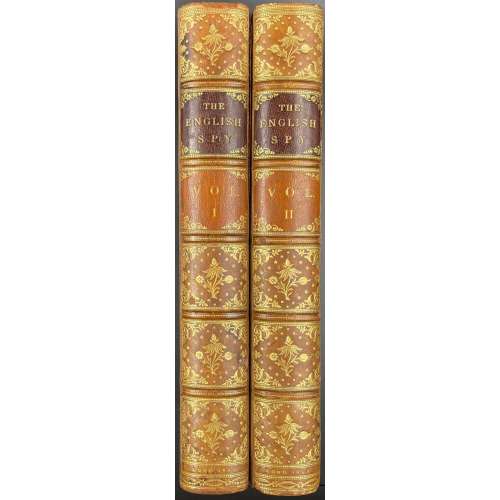 Two volumes 23.2 x 15.6 cm, uniformly bound in full polished calf by Riviere and Son (signed on fep verso), boards with triple gilt fillet border, spine with raised bands, gilt in compartments, gilt-lettered labels; dark blue endpapers, armorial bookplate of William Jennings with the motto “Honor Virtutis Premium” to front pastedown. Vol. 1: THE | ENGLISH SPY: | An Original Work | CHARACTERISTIC, SATIRICAL, AND | HUMOROUS. | COMPRISING | SCENES AND SKETCHES IN EVERY RANK OF SOCIETY, | BEING | PORTRAITS | OF THE | Illustrious, Eminent, Eccentric, and Notorious. | DRAWN FROM THE LIFE | BY BERNARD BLACKMANTLE. | THE ILLUSTRATIONS | DESIGNED BY | ROBERT CRUIKSHANK. | {vignette w/inscription: ‘By Frolic, Mirth, and Fancy gay, | Old Father Time is borne away.’ | — | LONDON : | PUBLISHED BY SHERWOOD, JONES, AND CO. | PATERNOSTER-ROW. | – | 1825. || Collation: [a]8 b4 B-H8 I4 K2 L-Z8 2A-2E8 2F3; total 221 leaves Pagination: [i-iii] iv-xxiii [xxiv] [1-3] 4-417 [418]; total 442 pages. Illustrations: 35 coloured plates, 1 uncoloured plate, and 29 woodcuts in text, incl vignette on title, all but four by Robert Cruikshank, 1 by G. M.B rightly (p. 335), 1 by T. Wageman (p. 413), and 2 by T. Rowlandson (pp. 411 and 416) Vol. 2: THE | ENGLISH SPY: | An Original Work | CHARACTERISTIC, SATIRICAL, AND | HUMOROUS. | COMPRISING | SCENES AND SKETCHES IN EVERY RANK OF SOCIETY, | BEING | PORTRAITS | OF THE | Illustrious, Eminent, Eccentric, and Notorious. | DRAWN FROM THE LIFE | BY BERNARD BLACKMANTLE. | THE ILLUSTRATIONS | DESIGNED BY | ROBERT CRUIKSHANK. | — | VOL. II. | — | {vignette w/inscription: ‘By Frolic, Mirth, and Fancy gay, | Old Father Time is borne away.’ | — | LONDON : | PUBLISHED BY SHERWOOD, GILBERT, AND PIPER, | PATERNOSTER-ROW. | – | 1826. || Collation: [A]-Z8 2A-2C8; total 208 leaves. [i-iii] iv-xv [xvi] [1-3] 4-399 [400]; total 416 pages. Illustrations: 36 coloured plates and 25 woodcuts in text. Catalogue raisonné: Martin-Hardie pp. 191-2; Tooley pp. 266-9; Abbey 325, pp.272-4 (see reflections regarding the ‘first issue’). Contributors: Charles Molloy Westmacott (British, c. 1788 – 1868) – author. Isaac Robert Cruikshank (British, 1789 – 1856) – artist, engraver. G. M. Brightly (British, fl. 1809 – 1827) – artist, engraver. Thomas Charles Wageman (British, 1787-1868) – artist, engraver Thomas Rowlandson (British, 1757 – 1827) – artist. Thomas Davison (British, 1794 – 1826) – printer. Sherwood, Jones, and Co. (London) – publisher. Sherwood, Gilbert, and Piper (London) – publisher. William Jennings – provenance
Two volumes 23.2 x 15.6 cm, uniformly bound in full polished calf by Riviere and Son (signed on fep verso), boards with triple gilt fillet border, spine with raised bands, gilt in compartments, gilt-lettered labels; dark blue endpapers, armorial bookplate of William Jennings with the motto “Honor Virtutis Premium” to front pastedown. Vol. 1: THE | ENGLISH SPY: | An Original Work | CHARACTERISTIC, SATIRICAL, AND | HUMOROUS. | COMPRISING | SCENES AND SKETCHES IN EVERY RANK OF SOCIETY, | BEING | PORTRAITS | OF THE | Illustrious, Eminent, Eccentric, and Notorious. | DRAWN FROM THE LIFE | BY BERNARD BLACKMANTLE. | THE ILLUSTRATIONS | DESIGNED BY | ROBERT CRUIKSHANK. | {vignette w/inscription: ‘By Frolic, Mirth, and Fancy gay, | Old Father Time is borne away.’ | — | LONDON : | PUBLISHED BY SHERWOOD, JONES, AND CO. | PATERNOSTER-ROW. | – | 1825. || Collation: [a]8 b4 B-H8 I4 K2 L-Z8 2A-2E8 2F3; total 221 leaves Pagination: [i-iii] iv-xxiii [xxiv] [1-3] 4-417 [418]; total 442 pages. Illustrations: 35 coloured plates, 1 uncoloured plate, and 29 woodcuts in text, incl vignette on title, all but four by Robert Cruikshank, 1 by G. M.B rightly (p. 335), 1 by T. Wageman (p. 413), and 2 by T. Rowlandson (pp. 411 and 416) Vol. 2: THE | ENGLISH SPY: | An Original Work | CHARACTERISTIC, SATIRICAL, AND | HUMOROUS. | COMPRISING | SCENES AND SKETCHES IN EVERY RANK OF SOCIETY, | BEING | PORTRAITS | OF THE | Illustrious, Eminent, Eccentric, and Notorious. | DRAWN FROM THE LIFE | BY BERNARD BLACKMANTLE. | THE ILLUSTRATIONS | DESIGNED BY | ROBERT CRUIKSHANK. | — | VOL. II. | — | {vignette w/inscription: ‘By Frolic, Mirth, and Fancy gay, | Old Father Time is borne away.’ | — | LONDON : | PUBLISHED BY SHERWOOD, GILBERT, AND PIPER, | PATERNOSTER-ROW. | – | 1826. || Collation: [A]-Z8 2A-2C8; total 208 leaves. [i-iii] iv-xv [xvi] [1-3] 4-399 [400]; total 416 pages. Illustrations: 36 coloured plates and 25 woodcuts in text. Catalogue raisonné: Martin-Hardie pp. 191-2; Tooley pp. 266-9; Abbey 325, pp.272-4 (see reflections regarding the ‘first issue’). Contributors: Charles Molloy Westmacott (British, c. 1788 – 1868) – author. Isaac Robert Cruikshank (British, 1789 – 1856) – artist, engraver. G. M. Brightly (British, fl. 1809 – 1827) – artist, engraver. Thomas Charles Wageman (British, 1787-1868) – artist, engraver Thomas Rowlandson (British, 1757 – 1827) – artist. Thomas Davison (British, 1794 – 1826) – printer. Sherwood, Jones, and Co. (London) – publisher. Sherwood, Gilbert, and Piper (London) – publisher. William Jennings – provenance -
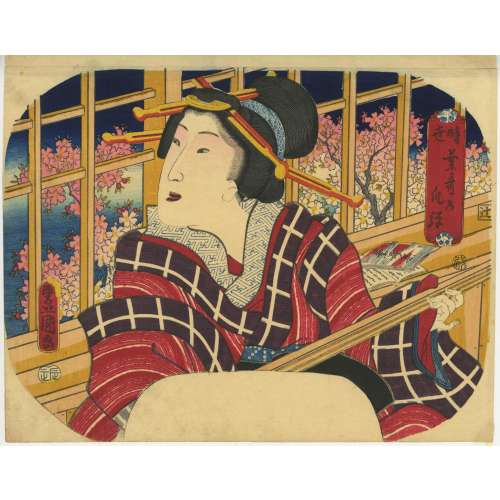 Artist: Utagawa Kunisada [歌川 国貞], a.k.a. Utagawa Toyokuni III [三代 歌川 豊国] (Japanese, 1786 – 1865). Signed: Toyokuni ga [豊国 画] in a red toshidama cartouche Publisher: Iseya Ichiemon [伊勢屋市右衛門] (Japanese, fl. c. 1820s – c. 1860s); seal Tsuji [辻] (Marks 16-029). Media: Untrimmed fan print (uchiwa-e), 225 x 295 mm, plus 10 mm paper strip glued on top (235 mm total height). Title: Plucking Popular Songs in Those Days [時世葉歌の爪弾] (Imayo ha-uta no tsuma-biki). Date seal and aratame seal: Ansei 3 (1856). Seller's Description: Uchiwa-e; picture intended for a summer fan. Here we see a relaxed beauty wearing loose layers of kimono and playing her shamisen instrument. She appears to be in the happy mood of spring, her singing inspired by the cherry blossoms in full bloom that we see outside of her window. She enjoys leisurely plucking with the plectrum of the shamisen and singing “ha-uta” (popular) songs. The title Ha-uta [葉歌] is normally written 端歌, which indicates a certain category of popular songs accompanied by shamisen with short texts that are drawn from daily life. Here however, the title葉歌 uses phonetically the same “ha葉“, referring to the title of the book of a collection of ha-uta songs, Matsu no ha [松の], which was published in five volumes in 1703 by Shûshôken 秀松軒. It is said that this collection of songs was written and sung by the blind (who were often musicians by livelihood). Behind her, lying on the window sill, we see two ha-uta songbooks, one open and one closed. The last half of the title tsuma-biki [爪弾] translates “to pluck with fingers” instead of a plectrum, which is the usual way of playing the shamisen.
Artist: Utagawa Kunisada [歌川 国貞], a.k.a. Utagawa Toyokuni III [三代 歌川 豊国] (Japanese, 1786 – 1865). Signed: Toyokuni ga [豊国 画] in a red toshidama cartouche Publisher: Iseya Ichiemon [伊勢屋市右衛門] (Japanese, fl. c. 1820s – c. 1860s); seal Tsuji [辻] (Marks 16-029). Media: Untrimmed fan print (uchiwa-e), 225 x 295 mm, plus 10 mm paper strip glued on top (235 mm total height). Title: Plucking Popular Songs in Those Days [時世葉歌の爪弾] (Imayo ha-uta no tsuma-biki). Date seal and aratame seal: Ansei 3 (1856). Seller's Description: Uchiwa-e; picture intended for a summer fan. Here we see a relaxed beauty wearing loose layers of kimono and playing her shamisen instrument. She appears to be in the happy mood of spring, her singing inspired by the cherry blossoms in full bloom that we see outside of her window. She enjoys leisurely plucking with the plectrum of the shamisen and singing “ha-uta” (popular) songs. The title Ha-uta [葉歌] is normally written 端歌, which indicates a certain category of popular songs accompanied by shamisen with short texts that are drawn from daily life. Here however, the title葉歌 uses phonetically the same “ha葉“, referring to the title of the book of a collection of ha-uta songs, Matsu no ha [松の], which was published in five volumes in 1703 by Shûshôken 秀松軒. It is said that this collection of songs was written and sung by the blind (who were often musicians by livelihood). Behind her, lying on the window sill, we see two ha-uta songbooks, one open and one closed. The last half of the title tsuma-biki [爪弾] translates “to pluck with fingers” instead of a plectrum, which is the usual way of playing the shamisen. -
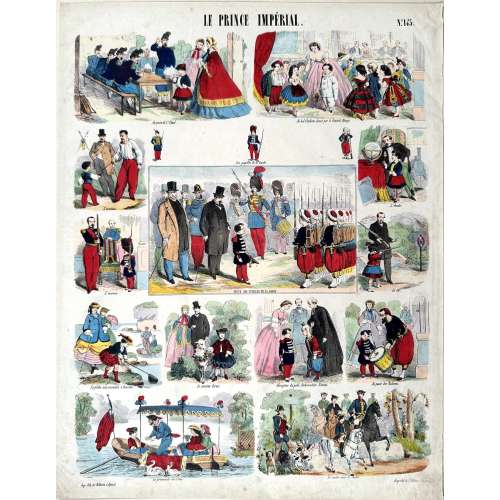 Hand-coloured woodcut on wove paper, 472 x 365 mm; black ink stamp “5275” to reverse. Top centre: "LE PRINCE IMPÉRIAL"; right: "№143." Image in the middle: Prince Impérial, with his father, conducts a review of the children's army "REVUE DES PUPILLES DE LA GARDE". Besides – five tiers of captioned cartoons. Bottom left: "Imp. lith. de Pellerin à Épinal"; right: Propriété de l’Éditeur. Déposé." Jean Charles Pellerin (French, 1756 – 1836) – printer/publisher.
Hand-coloured woodcut on wove paper, 472 x 365 mm; black ink stamp “5275” to reverse. Top centre: "LE PRINCE IMPÉRIAL"; right: "№143." Image in the middle: Prince Impérial, with his father, conducts a review of the children's army "REVUE DES PUPILLES DE LA GARDE". Besides – five tiers of captioned cartoons. Bottom left: "Imp. lith. de Pellerin à Épinal"; right: Propriété de l’Éditeur. Déposé." Jean Charles Pellerin (French, 1756 – 1836) – printer/publisher. -
 Torii Kiyomitsu II (Kiyomine), Japanese, 1787–1868. Courtesan and her Komura (Doll Festival). Series: Furyu Goyo no Matsu (Customs of 5 Pine Needles, the 5 great festivals). Publisher: Tsuruya Kiemon [Marks: 553].
Torii Kiyomitsu II (Kiyomine), Japanese, 1787–1868. Courtesan and her Komura (Doll Festival). Series: Furyu Goyo no Matsu (Customs of 5 Pine Needles, the 5 great festivals). Publisher: Tsuruya Kiemon [Marks: 553]. -
 Utagawa Kunisada (Japanese: 歌川 国貞; also known as Utagawa Toyokuni III (三代歌川豊国); 1786 – 12 January 1865).
Utagawa Kunisada (Japanese: 歌川 国貞; also known as Utagawa Toyokuni III (三代歌川豊国); 1786 – 12 January 1865).A young woman reading a book in the light of a lamp. Series: Arigataki miyo no kage-e (Shadow Pictures of an Auspicious Age). There are five known prints, half-length portraits of beauties, in this series, designed by Kunisada in ca. 1844. Another print from the series in this collection: SVJP-0306.2020: A young woman adjusting her hairpins in the light of a paper lantern.
Signed: Kōchōrō Toyokuni ga (香蝶楼豊国画).
Publisher: Maruya Kiyojiro.
Size: Vertical Ōban (37.5 x 25.4 cm). -
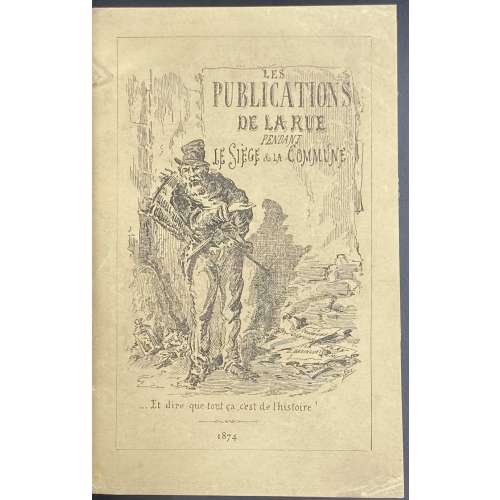 Convolute with three editions, dedicated to the Commune of Paris, 1871. (1) LES | Publications de la Rue | pendant | LE SIEGE ET LA COMMUNE | SATIRES — CANARDS — COMPLAINTES — CHANSONS | PLACARDS ET PAMPHLETS | BIBLIOGRAPHIE | PITTORESQUE ET ANECDOTIQUE | Par Firmin MAILLARD |{publisher’s device}| PARIS | AUGUSTE AUBRY, ÉDITEUR | 18, RUE SÉGUIER, 18 | 1874 || Pagination: ffl, original pictorial wrapper, [2] – blank / advert., [2] – h.t. / blank, [2] – h.t. / colophon imprim. PILLET FILS AINÉ, frontis. similar to front wrapper without '1874', [2] – t.p. / blank, [v] vi-xii, [1] 2-198, three blank leaves, back wrapper. (2) VILLE DE SAINT-DENIS | EXPOSITION D'ART & D'HISTOIRE | La Commune de Paris |18 Mars 1871 28 Mai | AVANT-PROPOS DE Lucien DESCAVES | de l’Académie Goncourt | PREFACE DE Jacques DORIOT | Député de la Seine, Maire de Saint-Denis | Du 17 Mars au 26 Mai 1935 | au Musée Municipal | 4, place de la Légion d’Honneur – Saint-Denis || Pagination: original pictorial wrapper in black and red, frontis., [2] - t.p. / blank, [2] – commité, v-xiii [xiv] 1-113 [114], 26 plates (13 leaves), blank back wrapper, spine tipped-in. (3) J. LEMONNYER | LES | JOURNAUX DE PARIS | PENDANT | LA COMMUNE | REVUE BIBLIOGRAPHIQUE COMPLETE | DE LA PRESSE PARISIENNE | du 19 Mars au 27 Mai | AVEC |{7 lines of text}| ET | UNE TABLE ALPHABÉTIQUE | DONNANT LE PRIX-COURANT DE CHAQUE COLLECTION | PARIS : J. LEMONNYER, Librarire | 73, Rue de Provence, 73 || Pagination: [2] - t.p. / blank, [2] – preface, [7] 8-94, green back wrapper w/advert., bfl. (lacks original front wrapper). Binding: Modern (20th century) red cloth, black label with gilt lettering to spine, matching marbled endpapers. Size: 18.5 x 13 cm; 12mo.
Convolute with three editions, dedicated to the Commune of Paris, 1871. (1) LES | Publications de la Rue | pendant | LE SIEGE ET LA COMMUNE | SATIRES — CANARDS — COMPLAINTES — CHANSONS | PLACARDS ET PAMPHLETS | BIBLIOGRAPHIE | PITTORESQUE ET ANECDOTIQUE | Par Firmin MAILLARD |{publisher’s device}| PARIS | AUGUSTE AUBRY, ÉDITEUR | 18, RUE SÉGUIER, 18 | 1874 || Pagination: ffl, original pictorial wrapper, [2] – blank / advert., [2] – h.t. / blank, [2] – h.t. / colophon imprim. PILLET FILS AINÉ, frontis. similar to front wrapper without '1874', [2] – t.p. / blank, [v] vi-xii, [1] 2-198, three blank leaves, back wrapper. (2) VILLE DE SAINT-DENIS | EXPOSITION D'ART & D'HISTOIRE | La Commune de Paris |18 Mars 1871 28 Mai | AVANT-PROPOS DE Lucien DESCAVES | de l’Académie Goncourt | PREFACE DE Jacques DORIOT | Député de la Seine, Maire de Saint-Denis | Du 17 Mars au 26 Mai 1935 | au Musée Municipal | 4, place de la Légion d’Honneur – Saint-Denis || Pagination: original pictorial wrapper in black and red, frontis., [2] - t.p. / blank, [2] – commité, v-xiii [xiv] 1-113 [114], 26 plates (13 leaves), blank back wrapper, spine tipped-in. (3) J. LEMONNYER | LES | JOURNAUX DE PARIS | PENDANT | LA COMMUNE | REVUE BIBLIOGRAPHIQUE COMPLETE | DE LA PRESSE PARISIENNE | du 19 Mars au 27 Mai | AVEC |{7 lines of text}| ET | UNE TABLE ALPHABÉTIQUE | DONNANT LE PRIX-COURANT DE CHAQUE COLLECTION | PARIS : J. LEMONNYER, Librarire | 73, Rue de Provence, 73 || Pagination: [2] - t.p. / blank, [2] – preface, [7] 8-94, green back wrapper w/advert., bfl. (lacks original front wrapper). Binding: Modern (20th century) red cloth, black label with gilt lettering to spine, matching marbled endpapers. Size: 18.5 x 13 cm; 12mo. -
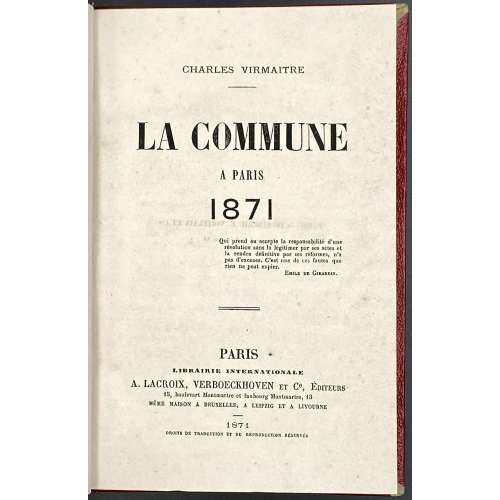 Title : CHARLES VIRMAITRE | LA COMMUNE | A PARIS | 1871 | {cit. 5 lines Emile de Girardin} | PARIS | LIBRAIRIE INTERNATIONALE | A. LACROIX, VERBOECKHOVEN ET Ce, ÉDITEURS | 15 boulevart Montmartre et faubourg Montmartre, 13 | MÉME MAISON A BRUXELLES, A LEIPZIG ET A LIVOURNE | 1871 | DROITS DE TRADUCTION ET DE REPRODUCTION RÉSERVÉS || Pagination : [2] – h.t. / imprint., [2] – t.p. / blank, [2] – dedicatation to Thiers / blank, [2] – table / blank, [1], 2-280; [total 288 pages]. Collation: 18mo; π4 1-1318 1514. Binding: red quarter morocco over red buckram boards, raised bands, gilt lettering, gilt flower lozenges in compartments, marbled endpapers.
Title : CHARLES VIRMAITRE | LA COMMUNE | A PARIS | 1871 | {cit. 5 lines Emile de Girardin} | PARIS | LIBRAIRIE INTERNATIONALE | A. LACROIX, VERBOECKHOVEN ET Ce, ÉDITEURS | 15 boulevart Montmartre et faubourg Montmartre, 13 | MÉME MAISON A BRUXELLES, A LEIPZIG ET A LIVOURNE | 1871 | DROITS DE TRADUCTION ET DE REPRODUCTION RÉSERVÉS || Pagination : [2] – h.t. / imprint., [2] – t.p. / blank, [2] – dedicatation to Thiers / blank, [2] – table / blank, [1], 2-280; [total 288 pages]. Collation: 18mo; π4 1-1318 1514. Binding: red quarter morocco over red buckram boards, raised bands, gilt lettering, gilt flower lozenges in compartments, marbled endpapers. -
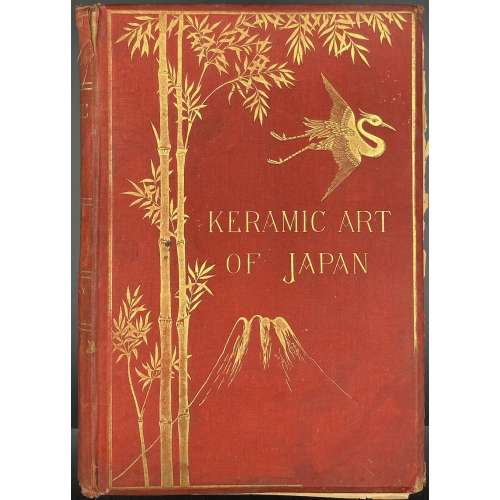 Title-page (in red and black): Keramic art of Japan, | BY | GEORGE A. AUDSLEY | AND | JAMES L. BOWES. | LONDON: HENRY SOTHERAN & CO., | 36 PICADILLY; 136, STRAND; 77 & 78, QUEEN STREET, CITY. | MANCHESTER: 49, CROSS STREET. | MDCCCLXXXI. || Description: 28.5 x 19.5 cm, publisher’s red cloth, bevelled boards, gilt lettering and tooling on front cover and spine, AEG, disbound. 304 p., 10 pl., 32 chromo-lithographed plates. This is the 2nd edition of the 1875 folio edition by the same publisher.. Contents: Introductory essay on Japanese art: p. 1-107; Keramic art of Japan: p. 108-260; Marks and monograms: p. 261-287, Index: p. 288-304. Contributors: George Ashdown Audsley (American, 1838 – 1925) – author. James Lord Bowes (British, 1834 – 1899) – author.
Title-page (in red and black): Keramic art of Japan, | BY | GEORGE A. AUDSLEY | AND | JAMES L. BOWES. | LONDON: HENRY SOTHERAN & CO., | 36 PICADILLY; 136, STRAND; 77 & 78, QUEEN STREET, CITY. | MANCHESTER: 49, CROSS STREET. | MDCCCLXXXI. || Description: 28.5 x 19.5 cm, publisher’s red cloth, bevelled boards, gilt lettering and tooling on front cover and spine, AEG, disbound. 304 p., 10 pl., 32 chromo-lithographed plates. This is the 2nd edition of the 1875 folio edition by the same publisher.. Contents: Introductory essay on Japanese art: p. 1-107; Keramic art of Japan: p. 108-260; Marks and monograms: p. 261-287, Index: p. 288-304. Contributors: George Ashdown Audsley (American, 1838 – 1925) – author. James Lord Bowes (British, 1834 – 1899) – author. -
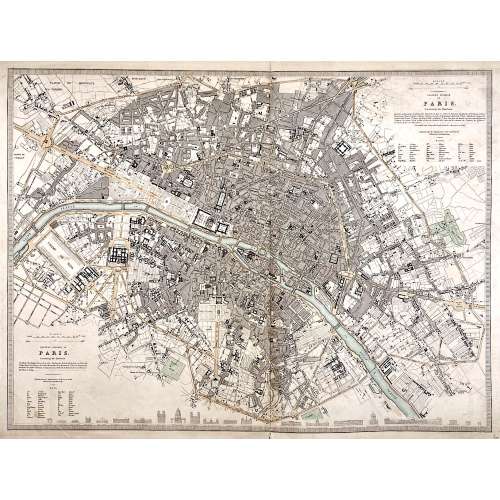 Top right: EASTERN DIVISION OF | PARIS. | Containing the Quartiers | {5 lines in italic} | Published under the Superintendence of the Society for the | Diffusion of Useful Knowledge || Bottom left: WESTERN DIVISION OF | PARIS. | Containing the Quartiers | {4 lines in italic} | Published under the Superintendence of the Society for the | Diffusion of Useful Knowledge || The map is framed, but there is no lettering beneath the frame to identify the cartographer, engraver, and publisher. However, we can attribute it to William Barnard Clarke (British, 1806 – 1865) and John Shury (fl. c. 1814-1844). The publisher is either Baldwin & Cradock or Chapman and Hall. Dimensions: Sheet: 40 x 60.8 cm; Image: 40 x 53.5 cm.
Top right: EASTERN DIVISION OF | PARIS. | Containing the Quartiers | {5 lines in italic} | Published under the Superintendence of the Society for the | Diffusion of Useful Knowledge || Bottom left: WESTERN DIVISION OF | PARIS. | Containing the Quartiers | {4 lines in italic} | Published under the Superintendence of the Society for the | Diffusion of Useful Knowledge || The map is framed, but there is no lettering beneath the frame to identify the cartographer, engraver, and publisher. However, we can attribute it to William Barnard Clarke (British, 1806 – 1865) and John Shury (fl. c. 1814-1844). The publisher is either Baldwin & Cradock or Chapman and Hall. Dimensions: Sheet: 40 x 60.8 cm; Image: 40 x 53.5 cm. -
 Bandō Mitsugorō III as Daihanji Kiyozumi and Arashi Koroku IV as Koganosuke in kabuki play Imoseyama, an example of womanly virtue (Imoseyama onna teikin). 大判事清澄 坂東三津五郎」(三代)・「久我之助 嵐小六」(四代) Artist: Shunkōsai Hokushū [春好斎北洲] (Japanese, fl. 1802 – 1832) Year: 1821 (3rd month). MFA description: “The Kabuki play Mount Imo and Mount Se: An Exemplary Tale of Womanly Virtue (Imoseyama onna teikin), originally based on a puppet play, is set in ancient Japan when the Soga clan served as regents to the emperor. Two children, Hinadori and Koganosuke, of rival court families, are held hostage under orders from the tyrant Soga no Iruka to ensure their families do not revolt. The children fall in love, but rather than create conflicts for their families they each vow to die by suicide. When the parents learn of their plans, they resolve to cooperate to overthrow Iruka. Here Koganosuke and his father Kiyozumi are shown; a companion sheet on the left would have shown Hinadori and her mother Sadaka.” The play Imoseyama, an example of womanly virtue (Imoseyama onna teikin), was staged at Osaka's Kado Shibai (Kadoza, Kado Gekijô, Kado no Shibai) from 3/1821. According to Herwig, it is the right sheet of a diptych (see below). MFA Accession number: 2011.128 Kabuki actors: Bandō Mitsugorō III [三代目 坂東 三津五郎] (Japanese, 1775 – 1831); other names: Bandō Minosuke I, Morita Kanjirô II, Bandō Mitahachi I, Bandō Minosuke I, Bandō Mitahachi I. Arashi Koroku IV [四代目嵐小六] (Japanese, 1783 – 1826)
Bandō Mitsugorō III as Daihanji Kiyozumi and Arashi Koroku IV as Koganosuke in kabuki play Imoseyama, an example of womanly virtue (Imoseyama onna teikin). 大判事清澄 坂東三津五郎」(三代)・「久我之助 嵐小六」(四代) Artist: Shunkōsai Hokushū [春好斎北洲] (Japanese, fl. 1802 – 1832) Year: 1821 (3rd month). MFA description: “The Kabuki play Mount Imo and Mount Se: An Exemplary Tale of Womanly Virtue (Imoseyama onna teikin), originally based on a puppet play, is set in ancient Japan when the Soga clan served as regents to the emperor. Two children, Hinadori and Koganosuke, of rival court families, are held hostage under orders from the tyrant Soga no Iruka to ensure their families do not revolt. The children fall in love, but rather than create conflicts for their families they each vow to die by suicide. When the parents learn of their plans, they resolve to cooperate to overthrow Iruka. Here Koganosuke and his father Kiyozumi are shown; a companion sheet on the left would have shown Hinadori and her mother Sadaka.” The play Imoseyama, an example of womanly virtue (Imoseyama onna teikin), was staged at Osaka's Kado Shibai (Kadoza, Kado Gekijô, Kado no Shibai) from 3/1821. According to Herwig, it is the right sheet of a diptych (see below). MFA Accession number: 2011.128 Kabuki actors: Bandō Mitsugorō III [三代目 坂東 三津五郎] (Japanese, 1775 – 1831); other names: Bandō Minosuke I, Morita Kanjirô II, Bandō Mitahachi I, Bandō Minosuke I, Bandō Mitahachi I. Arashi Koroku IV [四代目嵐小六] (Japanese, 1783 – 1826)
Ref.: [LIB-1197.2016] Arendie and Henk Herwig. Heroes of the kabuki stage: an introduction to kabuki with retellings of famous plays, illustrated by woodblock prints. — Amsterdam: Hotei Publishing, 2004; p. 72:
Ref: [LIB-2973.2022] Ukiyo-e: A journey through the Floating World / Exhibition catalogue (Japan, Jan-Jul 2014). — The Yomiuri Shimbun, 2014; № 358, p. 226. "Bandō Mitsugorō III as Grand arbiter Kiyosumi and Arashi Koroku IV as Koganosuke":
-
 Artist: Toyohara Chikanobu [豊原周延] (Japanese, 1838 – 1912) Signed: Chikanobu hitsu [周延筆] Publisher: [ 東京掘江町] Tokyo Horiemachi | [えん市製] Enshi-sei. Media: Fan print (uchiwa-e, 団扇絵), 192 x 172 mm. Possibly Iwai Kumesaburō IV [岩井粂三郎] (1856 – 1886) a.k.a. Iwai Hisajirō III [岩井久次郎] in the role of Ono no Komachi [小野乃小町] and Nakamura Shikan IV [中村芝翫] in the role of Kisen Hōshi [喜せん法師]. Play: The Six Immortal Poets in Colorful Guises [六歌仙体綵] (Rokkasen Sugata no irodori). Inscription: Left: Kisen [喜せん] | Shikan [芝翫] Right: Komachi [小町] | Kumesaburō [粂三郎]. Actors: Iwai Kumesaburō IV [岩井粂三郎] (1856 – 1886) a.k.a. Iwai Hisajirō III [岩井久次郎]. Nakamura Shikan IV [中村芝翫] (Japanese, 1831 – 1899); other names: Nakamura Fukusuke I [中村福助], Nakamura Masanosuke I, Nakamura Komasaburō, Nakamura Tamatarō I.
Artist: Toyohara Chikanobu [豊原周延] (Japanese, 1838 – 1912) Signed: Chikanobu hitsu [周延筆] Publisher: [ 東京掘江町] Tokyo Horiemachi | [えん市製] Enshi-sei. Media: Fan print (uchiwa-e, 団扇絵), 192 x 172 mm. Possibly Iwai Kumesaburō IV [岩井粂三郎] (1856 – 1886) a.k.a. Iwai Hisajirō III [岩井久次郎] in the role of Ono no Komachi [小野乃小町] and Nakamura Shikan IV [中村芝翫] in the role of Kisen Hōshi [喜せん法師]. Play: The Six Immortal Poets in Colorful Guises [六歌仙体綵] (Rokkasen Sugata no irodori). Inscription: Left: Kisen [喜せん] | Shikan [芝翫] Right: Komachi [小町] | Kumesaburō [粂三郎]. Actors: Iwai Kumesaburō IV [岩井粂三郎] (1856 – 1886) a.k.a. Iwai Hisajirō III [岩井久次郎]. Nakamura Shikan IV [中村芝翫] (Japanese, 1831 – 1899); other names: Nakamura Fukusuke I [中村福助], Nakamura Masanosuke I, Nakamura Komasaburō, Nakamura Tamatarō I. -
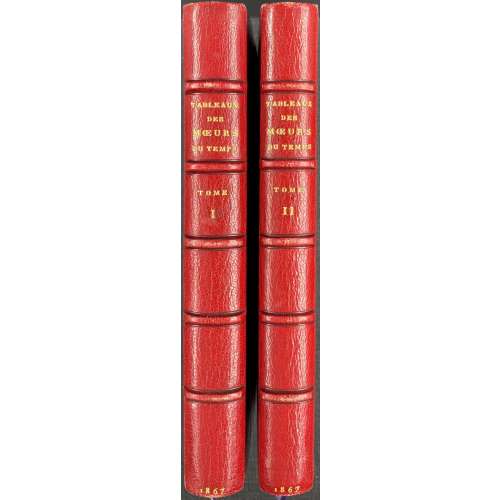 Two volumes in-12, 16.8 x 11.5 cm each, uniformly bound in ¾ red crushed morocco over marbled boards, spine with raised bands and gilt lettering, marbled endpapers, text printed on laid paper, 6 plates (3 in each vol.) on India paper pasted in on thick laid paper leaves. This edition seems similar to Nordmann I 203 but without Félicien Rops' frontispiece and plates, replaced by unsigned etchings attributed to Gustave Staal. Title-page (red and black): LE RICHE DE LA POPELINIÈRE | – | TABLEAUX | DES | MŒURS DU TEMPS | DANS LES DIFFÉRENTS AGES DE LA VIE | – | NOTICE DE | CHARLES MONSELET | – | TOME PREMIER (SECOND) | {fleuron} | PARIS | IMPRIMERIE DES CI-DEVANT FERMIERS GÉNÉRAUX | – | M D CCC L XVII || Vol. 1: π2 (h.t., t.p.) a4 (Notice), 1-1312 151 (Table); total 91 leaves plus three leaves of plates. Pagination: [4] [i] ii-vii [viii] [3] 4-168 [2]; total 182 pp, ils. facing pp. 59, 78, and 94. Vol. 2: π2 (h.t., t.p.), 1-1312, 152; total 88 leaves plus three leaves of plates. Pagination: [4] [1] 2-170 [2]; total 176 pp, ils. facing pp. 74, 78, and 145. Catalogue raisonné: Dutel I: A-1044 — without Félicien Rops ‘ornementations’, but with ‘6 gravures de 1865’. Dutel suggests that the edition was performed by A. Poulet-Malassis, Briard or Lécrivain. Catalogue Poulet-Malassis & ses amis description: № 43. LE RICHE DE LA POPELINIÈRE. Tableaux des mœurs du temps dans les diérents âges de la vie, tome premier (— second). Notice de M. Charles Monselet. Imprimerie des ci-devant fermiers généraux, Paris, M D CCC LXVII [A. Poulet-Malassis, 1867]. Exemplaire sans le frontispice de Félicien Rops mais bien complet des 6 figures de Staal, justification qui illustre les aléas de la confection des publications clandestines. D’une part, c’est une autre édition qui est décrite par Launay. L’exemplaire vendu chez Maître Loudmer avait 6 figures, comme ici. Cluzel a vu un “front. et 4 vignettes de Rops plus cinq figures libres (par Staal)”, Simonson a vu 5 figures de Rops, etc., etc. Il y a 3 bandeaux et 3 culs-de-lampe de Rops qui ont été fréquemment utilisés par d’autres éditeurs pour d’autres titres pendant toute la seconde moitié du xixe siècle. La Léonina présente une fiche détaillée sur 4 pages. 3 bandeaux et 3 culs-de-lampe gravés sur bois de Rops. Bibliographie : Pia 1389, Launay 327, Gay 6-308, Pey 122 (1800 frs avec 5 figures), PC 503 et 504, Lemonnyer 3-1173, LL 66, Leonina 81, Nordmann 1-203, Dutel A-1043. Contributors: Alexandre Jean Joseph Le Riche de La Popelinière (French, 1693 – 1762) – author. Charles Monselet (French, 1825 – 1888) – author (foreword). Pierre-Gustave-Eugène Staal (French, 1817 – 1882) – artist. Auguste Poulet-Malassis (French, 1825 – 1878) – publisher.
Two volumes in-12, 16.8 x 11.5 cm each, uniformly bound in ¾ red crushed morocco over marbled boards, spine with raised bands and gilt lettering, marbled endpapers, text printed on laid paper, 6 plates (3 in each vol.) on India paper pasted in on thick laid paper leaves. This edition seems similar to Nordmann I 203 but without Félicien Rops' frontispiece and plates, replaced by unsigned etchings attributed to Gustave Staal. Title-page (red and black): LE RICHE DE LA POPELINIÈRE | – | TABLEAUX | DES | MŒURS DU TEMPS | DANS LES DIFFÉRENTS AGES DE LA VIE | – | NOTICE DE | CHARLES MONSELET | – | TOME PREMIER (SECOND) | {fleuron} | PARIS | IMPRIMERIE DES CI-DEVANT FERMIERS GÉNÉRAUX | – | M D CCC L XVII || Vol. 1: π2 (h.t., t.p.) a4 (Notice), 1-1312 151 (Table); total 91 leaves plus three leaves of plates. Pagination: [4] [i] ii-vii [viii] [3] 4-168 [2]; total 182 pp, ils. facing pp. 59, 78, and 94. Vol. 2: π2 (h.t., t.p.), 1-1312, 152; total 88 leaves plus three leaves of plates. Pagination: [4] [1] 2-170 [2]; total 176 pp, ils. facing pp. 74, 78, and 145. Catalogue raisonné: Dutel I: A-1044 — without Félicien Rops ‘ornementations’, but with ‘6 gravures de 1865’. Dutel suggests that the edition was performed by A. Poulet-Malassis, Briard or Lécrivain. Catalogue Poulet-Malassis & ses amis description: № 43. LE RICHE DE LA POPELINIÈRE. Tableaux des mœurs du temps dans les diérents âges de la vie, tome premier (— second). Notice de M. Charles Monselet. Imprimerie des ci-devant fermiers généraux, Paris, M D CCC LXVII [A. Poulet-Malassis, 1867]. Exemplaire sans le frontispice de Félicien Rops mais bien complet des 6 figures de Staal, justification qui illustre les aléas de la confection des publications clandestines. D’une part, c’est une autre édition qui est décrite par Launay. L’exemplaire vendu chez Maître Loudmer avait 6 figures, comme ici. Cluzel a vu un “front. et 4 vignettes de Rops plus cinq figures libres (par Staal)”, Simonson a vu 5 figures de Rops, etc., etc. Il y a 3 bandeaux et 3 culs-de-lampe de Rops qui ont été fréquemment utilisés par d’autres éditeurs pour d’autres titres pendant toute la seconde moitié du xixe siècle. La Léonina présente une fiche détaillée sur 4 pages. 3 bandeaux et 3 culs-de-lampe gravés sur bois de Rops. Bibliographie : Pia 1389, Launay 327, Gay 6-308, Pey 122 (1800 frs avec 5 figures), PC 503 et 504, Lemonnyer 3-1173, LL 66, Leonina 81, Nordmann 1-203, Dutel A-1043. Contributors: Alexandre Jean Joseph Le Riche de La Popelinière (French, 1693 – 1762) – author. Charles Monselet (French, 1825 – 1888) – author (foreword). Pierre-Gustave-Eugène Staal (French, 1817 – 1882) – artist. Auguste Poulet-Malassis (French, 1825 – 1878) – publisher. -
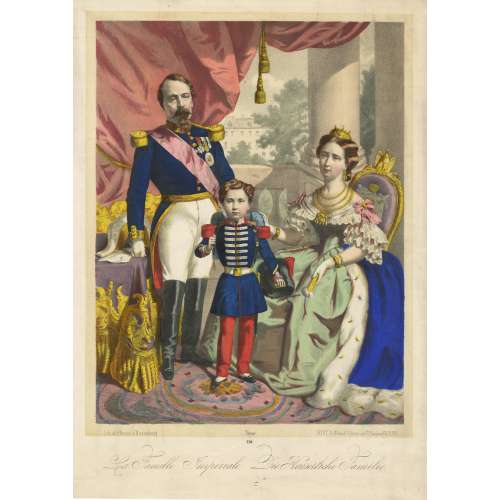 Hand-coloured lithography on wove paper, 395 x 280 mm; black ink stamp “5309” to reverse. On image: artist's initials "L. H."; on stone: "Lith. de Fr. Wentzel a Wissembourg. — Déposé — DÉPÔT, Fr. Wentzel Editeur rue St. Jacques 65, PARIS"; below centre: "239"; bottom : La famille Impériale. Die Kaizerliche Familie. Napoleon III [Charles-Louis Napoléon Bonaparte] (French, 1808 – 1873) Eugénie de Montijo [L'impératrice Eugénie] (Spanish-French, 1826 – 1920) Napoléon, Prince Imperial (Napoléon Eugène Louis Jean Joseph Bonaparte] (French, 1856 – 1879) Jean Frédéric Wentzel (French, 1807 – 1869) – publisher/printer.
Hand-coloured lithography on wove paper, 395 x 280 mm; black ink stamp “5309” to reverse. On image: artist's initials "L. H."; on stone: "Lith. de Fr. Wentzel a Wissembourg. — Déposé — DÉPÔT, Fr. Wentzel Editeur rue St. Jacques 65, PARIS"; below centre: "239"; bottom : La famille Impériale. Die Kaizerliche Familie. Napoleon III [Charles-Louis Napoléon Bonaparte] (French, 1808 – 1873) Eugénie de Montijo [L'impératrice Eugénie] (Spanish-French, 1826 – 1920) Napoléon, Prince Imperial (Napoléon Eugène Louis Jean Joseph Bonaparte] (French, 1856 – 1879) Jean Frédéric Wentzel (French, 1807 – 1869) – publisher/printer. -

Жуковский Ю. Г. Политические и общественные теории XVI-го века. - С.Петербург, 1866. Типография А. Головачева. // Материалы для общественной науки. - 163 с.
Схоластика.
Макиавелли и Томас Мор.
Реформация: Лютер, Кальвин, анабаптисты.
Жан Боден.
[Штамп на титуле: A. Namoradze, Tiflis. 1935.]
-
 Artist: Utagawa Kunisada [歌川 国貞] a.k.a. Utagawa Toyokuni III [三代歌川豊国] (Japanese, 1786 – 1865). Block cutter: Horikō (Kiyomizu) Ryūzō [彫工 柳三]. Publisher: Ebisuya Shoshichi [恵比寿屋庄七], Kinshōdō (Japanese, fl. c. 1846 – 1883). Actor Morita Kan'ya XI as Saito Tarozaemon Toshiyuki (Morito Kan'ya, Saito Tarozaemon Toshiyuki) Signed Toyokuni ga within the artist's Toshidama cartouche, publisher's seal Sho, Kinshodo, carver's seal Horiko Ryusan, censor's seal aratame with date 1860, 3rd month. Date: 3/1860. Oban tate-e; 36.5 x 25.3 cm. The actor Morita Kan'ya XI (1802-1863) is in the role of Saito Tarozaemon Toshiyuki from the play Oto no Miya Asahi no Yoroi (Oto no Miyo and the Armor of the Rising Sun). The play picks up following the Genko War of 1331-33 in which Emperor Go-Daigo (1288-1339) led a failed uprising against the ruling Hojo clan. Tarozaemon was a Hojo warlord and is credited with much of the victory. After the conflict, his lord Norisada receives a summer festival lantern from the courtesan Sanmi-no-Tsubone, which bears a riddling inscription. He and Tarozaemon deliberate over the courtesan and her message for quite some time until they realize that she is attempting to manipulate Norisada in the hopes of returning the Emperor from exile. Following this revelation, Norisada reinterprets the message to mean kiriko, literally "to cut a child," and determines that Sanmi-no-Tsubone's son must be killed. He instructs Tarozaemon to do the deed. However, unbeknownst to Norisada and in spite of his allegiance to the Hojo clan, Tarozaemon is sympathetic to Sanmi-no-Tsubone and her son. At one time, his own daughter had served in the Imperial Palace and was spared execution only through Sanmi-no-Tsubone's intervention. As repayment of that debt, he kills his own grandson in the other boy's stead and returns to Norisada to report that he had accomplished the mission. This print is from a series of portraits that Kunisada undertook very late in life and has been named Kinshodo-ban yakusha okubi-e (Kinshodo's Large-Head Actor Portraits) in reference to the publisher, Ebisuya Shochochi of Kinshodo. The series depicted great actors from the past and present in their famous roles. Kunisada was guided by images from his own oeuvre: he recorded Kan'ya in this role in the 8th month of 1829. As this was meant to be Kunisada's grandest actor series, it was executed on thick paper with the best possible pigments and the highest level of craftsmanship. In this unusual frontal portrait, Kunisada presents Morita Kan'ya XI as the loyal Tarozaemon with his eyes rolling upward and his jaw set in grim determination to commit the unthinkable act in an ultimate display of samurai honour. Text by Scholten Japanese Art, New York. Ref.: Waseda University Theatre Museum (enpaku.waseda.ac.jp), accession no. 100-5261 (for 1829 portrait of the same); [LIB-1212.2017] Robert Schaap. Kunisada: Imaging, drama and beauty. — Leiden: Hotei Publishing, 2016, p. 165 (№ 16). Andreas Marks. Publishers of Japanese woodblock prints: A compendium. Ebisuya Shoshichi (1846-83) - P6032.
Artist: Utagawa Kunisada [歌川 国貞] a.k.a. Utagawa Toyokuni III [三代歌川豊国] (Japanese, 1786 – 1865). Block cutter: Horikō (Kiyomizu) Ryūzō [彫工 柳三]. Publisher: Ebisuya Shoshichi [恵比寿屋庄七], Kinshōdō (Japanese, fl. c. 1846 – 1883). Actor Morita Kan'ya XI as Saito Tarozaemon Toshiyuki (Morito Kan'ya, Saito Tarozaemon Toshiyuki) Signed Toyokuni ga within the artist's Toshidama cartouche, publisher's seal Sho, Kinshodo, carver's seal Horiko Ryusan, censor's seal aratame with date 1860, 3rd month. Date: 3/1860. Oban tate-e; 36.5 x 25.3 cm. The actor Morita Kan'ya XI (1802-1863) is in the role of Saito Tarozaemon Toshiyuki from the play Oto no Miya Asahi no Yoroi (Oto no Miyo and the Armor of the Rising Sun). The play picks up following the Genko War of 1331-33 in which Emperor Go-Daigo (1288-1339) led a failed uprising against the ruling Hojo clan. Tarozaemon was a Hojo warlord and is credited with much of the victory. After the conflict, his lord Norisada receives a summer festival lantern from the courtesan Sanmi-no-Tsubone, which bears a riddling inscription. He and Tarozaemon deliberate over the courtesan and her message for quite some time until they realize that she is attempting to manipulate Norisada in the hopes of returning the Emperor from exile. Following this revelation, Norisada reinterprets the message to mean kiriko, literally "to cut a child," and determines that Sanmi-no-Tsubone's son must be killed. He instructs Tarozaemon to do the deed. However, unbeknownst to Norisada and in spite of his allegiance to the Hojo clan, Tarozaemon is sympathetic to Sanmi-no-Tsubone and her son. At one time, his own daughter had served in the Imperial Palace and was spared execution only through Sanmi-no-Tsubone's intervention. As repayment of that debt, he kills his own grandson in the other boy's stead and returns to Norisada to report that he had accomplished the mission. This print is from a series of portraits that Kunisada undertook very late in life and has been named Kinshodo-ban yakusha okubi-e (Kinshodo's Large-Head Actor Portraits) in reference to the publisher, Ebisuya Shochochi of Kinshodo. The series depicted great actors from the past and present in their famous roles. Kunisada was guided by images from his own oeuvre: he recorded Kan'ya in this role in the 8th month of 1829. As this was meant to be Kunisada's grandest actor series, it was executed on thick paper with the best possible pigments and the highest level of craftsmanship. In this unusual frontal portrait, Kunisada presents Morita Kan'ya XI as the loyal Tarozaemon with his eyes rolling upward and his jaw set in grim determination to commit the unthinkable act in an ultimate display of samurai honour. Text by Scholten Japanese Art, New York. Ref.: Waseda University Theatre Museum (enpaku.waseda.ac.jp), accession no. 100-5261 (for 1829 portrait of the same); [LIB-1212.2017] Robert Schaap. Kunisada: Imaging, drama and beauty. — Leiden: Hotei Publishing, 2016, p. 165 (№ 16). Andreas Marks. Publishers of Japanese woodblock prints: A compendium. Ebisuya Shoshichi (1846-83) - P6032. -
 Woman Looking out a Round Window at a Woman with a Komusō Hat.
Woman Looking out a Round Window at a Woman with a Komusō Hat.Artist Koikawa Harumasa (a.k.a. Banki): fl. 1801–18. Wikipedia: Koikawa Harumasa (恋川 春政; active 1800–1820), later called Banki Harumasa (晩器 春政). Associated with Katsukawa school.
Signed: Banki ga (on the bamboo flower container in the background). Censor's seal: kiwame. Mark of unidentified publisher, Genshoku #1017; Marks U084 Ibiko, p. 387.
References:
Jacob Pins #828.
-
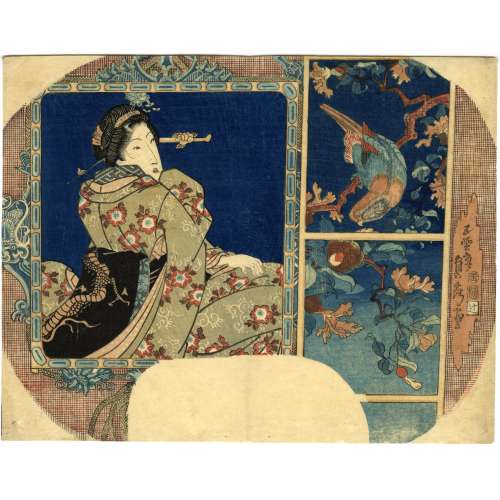 Artist: Utagawa Sadahide [歌川 貞秀], a.k.a. Gountei Sadahide [五雲亭 貞秀] (1807 – c. 1878/9). Publisher: Iseya Ichiemon [伊勢屋市右衛門] (Japanese, fl. c 1823 – 1864), seal name Kaku-Tsuji [角辻]. Signed: Gountei Sadahide ga [五雲亭貞秀画] Censor's seal: kiwame, date seal: Tenpō 3 (1832). Size: Uncut fan print (uchiwa-e); 218 x 282 mm. Portrait of a young woman dressed in a green kimono decorated with arabesque (karakusa) and flowers, her black obi adorned with a dragon, in a western-style frame, on a blue background; and a painting of a parrot on a pomegranate tree. A similar design was used by Sadahide in 1860, described in detail by Sebastian Izzard in his Japanese Prints of the Mid-Nineteenth Century: 1830–1865, September 20–October 24, 2006 exhibition: Picture of a Curio Shop in Yokohama: reverse painting on glass of a crimson parrot, coloured copperplate engraving of a mother and child (Yokohama urimono mise no zu: gyokuban abura-e, doban-e saishiki). Colour woodblock print: oban tate-e, 143/8 x 93/4 in. (36.5 x 24.8 cm.); Man-en I/3 (3/1860) Series: Picture of Goods for Sale in Yokohama (Yokohama urimono zue no uchi) Signature: Gountei Sadahide ga, double toshidama seal Publisher: Daikokuya Kinnosuke.
Artist: Utagawa Sadahide [歌川 貞秀], a.k.a. Gountei Sadahide [五雲亭 貞秀] (1807 – c. 1878/9). Publisher: Iseya Ichiemon [伊勢屋市右衛門] (Japanese, fl. c 1823 – 1864), seal name Kaku-Tsuji [角辻]. Signed: Gountei Sadahide ga [五雲亭貞秀画] Censor's seal: kiwame, date seal: Tenpō 3 (1832). Size: Uncut fan print (uchiwa-e); 218 x 282 mm. Portrait of a young woman dressed in a green kimono decorated with arabesque (karakusa) and flowers, her black obi adorned with a dragon, in a western-style frame, on a blue background; and a painting of a parrot on a pomegranate tree. A similar design was used by Sadahide in 1860, described in detail by Sebastian Izzard in his Japanese Prints of the Mid-Nineteenth Century: 1830–1865, September 20–October 24, 2006 exhibition: Picture of a Curio Shop in Yokohama: reverse painting on glass of a crimson parrot, coloured copperplate engraving of a mother and child (Yokohama urimono mise no zu: gyokuban abura-e, doban-e saishiki). Colour woodblock print: oban tate-e, 143/8 x 93/4 in. (36.5 x 24.8 cm.); Man-en I/3 (3/1860) Series: Picture of Goods for Sale in Yokohama (Yokohama urimono zue no uchi) Signature: Gountei Sadahide ga, double toshidama seal Publisher: Daikokuya Kinnosuke.
-
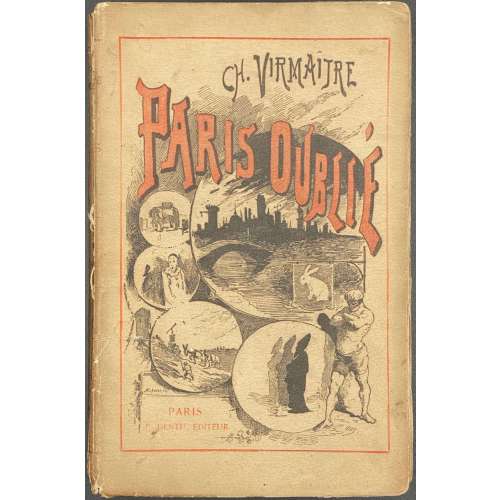 Cover: CH. VIRMAÎTRE | PARIS OUBLIÉ — PARIS | E. DENTU, ÉDITEUR || Title page: CHARLES VIRMAÎTRE | PARIS OUBLIÉ | {publisher’s device} | PARIS | E. DENTU, ÉDITEUR | LIBRAIRE DE LA SOCIÉTÉ DES GENTES DE LETTRES | PALAIS-ROYAL, 15-17-19, GALERIE D’ORLÉANS | 1886 | Tous droits réservés. || Pagination: publisher’s pictorial wrapper, ffl, [2] – t.p. / blank, 1-327 [328 blank], bfl, publisher’s advert. to back wrapper.
Cover: CH. VIRMAÎTRE | PARIS OUBLIÉ — PARIS | E. DENTU, ÉDITEUR || Title page: CHARLES VIRMAÎTRE | PARIS OUBLIÉ | {publisher’s device} | PARIS | E. DENTU, ÉDITEUR | LIBRAIRE DE LA SOCIÉTÉ DES GENTES DE LETTRES | PALAIS-ROYAL, 15-17-19, GALERIE D’ORLÉANS | 1886 | Tous droits réservés. || Pagination: publisher’s pictorial wrapper, ffl, [2] – t.p. / blank, 1-327 [328 blank], bfl, publisher’s advert. to back wrapper. -
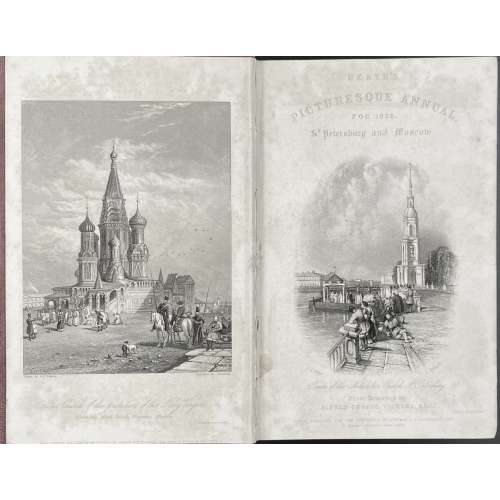 Engraved title: HEATH'S | PICTURESQUE ANNUAL, | FOR 1836. | St. Petersburg and Moscow. | {vignette Nikolskoi church signed: A.G. Vickers — E. Radclyffe} | Tower of the Nikolskoi church St. Petersburg | From Drawings by | ALFRED GEORGE VICKERS, ESQ. | Printed by Arnold & Fisher | LONDON, PUBLISHED FOR THE PROPRIETOR, BY LONGMAN & Co. PATERNOSTER ROW: | RITTNER & Co. PARIS: & ASHER, BERLIN. || Title page: A JOURNEY | TO ST. PETERSBURG AND MOSCOW | THROUGH COURLAND AND LIVONIA. | BY | LEITCH RITCHIE, Esq. | AUTHOR OF “TURNER’S ANNUAL TOUR”, “SCHINDERHANNES,” &c. | WITH TWENTY-FIVE SPLENDID ENGRAVINGS, | BY THE FIRST ARTISTS, AFTER DRAWINGS, | BY A.G. VICKERS, Esq. | LONDON: | LONGMAN, REES, BROWN, GREEN, AND LONGMAN. | PARIS: RITTNER AND GOUPILL. BERLIN: A. ASHER. | 1836. || Imprint: LONDON: | PRINTED BY J. HADDON AND CO., DOCTORS’ COMMONS. Pagination: [i-iii] iv [4] [1] 2-256, total 264 pages + 25 plates. Collation: 12mo; π4, B-Y6 Z2; total 132 leaves + frontispiece, engraved title and 23 leaves of steel-engraved plates w/tissue guards, extraneous to collation. Binding: full red morocco, blind-stamped boards, gilt-lettered spine, all edges gilt, 12mo, 20 x 13 cm. Note: Schinderhannes – real name Johannes Bückler (German, c.1778 – 1803): Leitch Ritchie. Schinderhannes: the Robber of the Rhine. (Library of Romance). — London: Smith, Elder, and Co., 1833. Contributors:
Engraved title: HEATH'S | PICTURESQUE ANNUAL, | FOR 1836. | St. Petersburg and Moscow. | {vignette Nikolskoi church signed: A.G. Vickers — E. Radclyffe} | Tower of the Nikolskoi church St. Petersburg | From Drawings by | ALFRED GEORGE VICKERS, ESQ. | Printed by Arnold & Fisher | LONDON, PUBLISHED FOR THE PROPRIETOR, BY LONGMAN & Co. PATERNOSTER ROW: | RITTNER & Co. PARIS: & ASHER, BERLIN. || Title page: A JOURNEY | TO ST. PETERSBURG AND MOSCOW | THROUGH COURLAND AND LIVONIA. | BY | LEITCH RITCHIE, Esq. | AUTHOR OF “TURNER’S ANNUAL TOUR”, “SCHINDERHANNES,” &c. | WITH TWENTY-FIVE SPLENDID ENGRAVINGS, | BY THE FIRST ARTISTS, AFTER DRAWINGS, | BY A.G. VICKERS, Esq. | LONDON: | LONGMAN, REES, BROWN, GREEN, AND LONGMAN. | PARIS: RITTNER AND GOUPILL. BERLIN: A. ASHER. | 1836. || Imprint: LONDON: | PRINTED BY J. HADDON AND CO., DOCTORS’ COMMONS. Pagination: [i-iii] iv [4] [1] 2-256, total 264 pages + 25 plates. Collation: 12mo; π4, B-Y6 Z2; total 132 leaves + frontispiece, engraved title and 23 leaves of steel-engraved plates w/tissue guards, extraneous to collation. Binding: full red morocco, blind-stamped boards, gilt-lettered spine, all edges gilt, 12mo, 20 x 13 cm. Note: Schinderhannes – real name Johannes Bückler (German, c.1778 – 1803): Leitch Ritchie. Schinderhannes: the Robber of the Rhine. (Library of Romance). — London: Smith, Elder, and Co., 1833. Contributors:Author: Leitch Ritchie (British, 1800 – 1865).
Illustrator: Alfred Gomersal Vickers (British, 1810 – 1837).
Publisher: Longman, Rees, Orme, Brown, Green and Longman (London).
Engravers: Turnbull, Thomas (British, fl. 1830s); Radclyffe, Edward (British, 1810 – 1863); Jorden, Henry (British, fl. 1829 – 1838); Fisher, Samuel (British, 1806 – 1851); Willmore, James Tibbits (British, 1800 – 1863); Higham, Thomas (British, 1795 – 1844); Appleton, J. W. (British, fl. 1834 – 1843); Wallis, Robert William (British, 1794 – 1878); Chevalier, William (British, 1804 – 1866); Kernot, James Harfield (British, 1802 – 1858); Lewis, James (British, 1782 – 1858); Carter, James (British, 1798 – 1855). Printer: John Haddon & Co. (London). Reference: Metropolitan Museum (NY); Royal Collection Trust (London). -
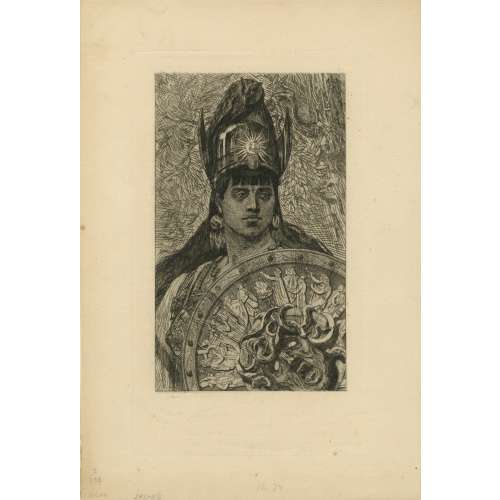
Etching and drypoint on wove paper, depicting Athena with an awl on her helmet and holding a shield with Medusa head. Owner's stamp 'LvM' on verso.
Dimensions: Paper: 38.7 x 26.5 cm; Plate: 31 x 18 cm; Image: 24.5 x 14.5 cm.
Catalogue raisonné: Arthur Hubschmid (1977): 317; Graphics irreverent and erotic (1968): 41.
-
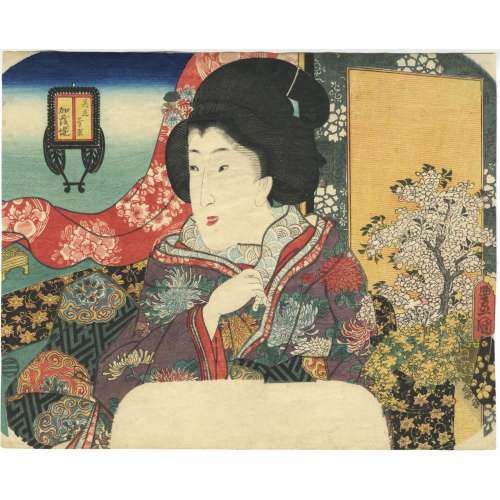 Title: On the Banks of the Kamo River [加茂堤] (Kamo Tsutsumi), sometimes transcribed as Kamo Zutsumi. Series: A Parody of Sugawara [美立菅原] (Mitate Sugawara). The word mitate is usually written as 見立 but here it is 美立, like on another Kunisada's fan print A beauty reading a book on a balcony overlooking a bay: A Parody of Sugawara Stripes (see SVJP-0334.2021 in this collection). On the Banks of the Kamo River is a scene from the play Sugawara's Secrets of Calligraphy [菅原伝授手習鑑] (Sugawara Denju Tenarai Kagami); it was originally written for the puppet theatre (Bunraku) and staged for the first time in the 8th lunar month of 1746 in Ôsaka at the Takemotoza. It was adapted for Kabuki the following month and staged for the first time in Kyôto at the Kitagawa no Shibai, produced by Nakamura Kiyosaburô I. It was also performed for the first time in Edo, at the Ichimuraza, in the 3rd lunar month of 1747. The shape of the cartouche resembles an ox cart viewed from the back which alludes to the scene Fighting for the Carriage (Kuruma biki). Artist: Utagawa Kunisada [歌川 国貞] a.k.a. Utagawa Toyokuni III [三代 歌川 豊国] (Japanese, 1786 – 1865). Signed: Toyokuni [豊国] in a red toshidama cartouche. The character ga [画] is missing (cut out). Publisher’s seal: Ibaya Senzaburō [伊場屋仙三郎] (Japanese, fl. 1815 – 1869). The date seal and censor seals were possibly trimmed out. According to [LIB-3008.2022] Andreas Marks (Tuttle, 2010; p. 267), the series was produced by Ibaya in 1851. Ref.: (1) Samuel L. Leiter. Historical dictionary of Japanese traditional theatre (Historical dictionaries of literature and the arts) / 2nd edition. – Lanham: Rowman & Littlefield, 2014©. (2) Andreas Marks. Japanese woodblock prints: Artists, publishers and masterworks, 1680 – 1900 / Foreword by Stephen Addiss. — Tuttle Publishing, 2010©. Acknowledgements: This masterpiece of ukiyo-e would not be properly described without input from Elena Varshavsky and Horst Graebner.
Title: On the Banks of the Kamo River [加茂堤] (Kamo Tsutsumi), sometimes transcribed as Kamo Zutsumi. Series: A Parody of Sugawara [美立菅原] (Mitate Sugawara). The word mitate is usually written as 見立 but here it is 美立, like on another Kunisada's fan print A beauty reading a book on a balcony overlooking a bay: A Parody of Sugawara Stripes (see SVJP-0334.2021 in this collection). On the Banks of the Kamo River is a scene from the play Sugawara's Secrets of Calligraphy [菅原伝授手習鑑] (Sugawara Denju Tenarai Kagami); it was originally written for the puppet theatre (Bunraku) and staged for the first time in the 8th lunar month of 1746 in Ôsaka at the Takemotoza. It was adapted for Kabuki the following month and staged for the first time in Kyôto at the Kitagawa no Shibai, produced by Nakamura Kiyosaburô I. It was also performed for the first time in Edo, at the Ichimuraza, in the 3rd lunar month of 1747. The shape of the cartouche resembles an ox cart viewed from the back which alludes to the scene Fighting for the Carriage (Kuruma biki). Artist: Utagawa Kunisada [歌川 国貞] a.k.a. Utagawa Toyokuni III [三代 歌川 豊国] (Japanese, 1786 – 1865). Signed: Toyokuni [豊国] in a red toshidama cartouche. The character ga [画] is missing (cut out). Publisher’s seal: Ibaya Senzaburō [伊場屋仙三郎] (Japanese, fl. 1815 – 1869). The date seal and censor seals were possibly trimmed out. According to [LIB-3008.2022] Andreas Marks (Tuttle, 2010; p. 267), the series was produced by Ibaya in 1851. Ref.: (1) Samuel L. Leiter. Historical dictionary of Japanese traditional theatre (Historical dictionaries of literature and the arts) / 2nd edition. – Lanham: Rowman & Littlefield, 2014©. (2) Andreas Marks. Japanese woodblock prints: Artists, publishers and masterworks, 1680 – 1900 / Foreword by Stephen Addiss. — Tuttle Publishing, 2010©. Acknowledgements: This masterpiece of ukiyo-e would not be properly described without input from Elena Varshavsky and Horst Graebner. -
 Artist: Utagawa Kunisada [歌川 国貞] a.k.a. Utagawa Toyokuni III [三代歌川豊国] (Japanese, 1786 – 1865). Signed: Ōju Toyokuni ga [応需豊国画], in a toshidama cartouche. Double nanushi censor seals Mera & Murata (1846-50). Publisher: Kojimaya Jūbei [小嶋屋重兵衛] (Japanese, fl. c. 1797 – 1869). Kabuki actor Ichikawa Danjūrō VIII [市川団十郎] (Ichikawa Ebizō VI, Ichikawa Shinnosuke II, Japanese, 1823 – 1854) watches the sunrise over Mount Fuji. The complete set of series Moon, Sun, Stars [月日星] (tsuki-hi-hoshi/boshi), three sources of light (sankō) [三光]:
Artist: Utagawa Kunisada [歌川 国貞] a.k.a. Utagawa Toyokuni III [三代歌川豊国] (Japanese, 1786 – 1865). Signed: Ōju Toyokuni ga [応需豊国画], in a toshidama cartouche. Double nanushi censor seals Mera & Murata (1846-50). Publisher: Kojimaya Jūbei [小嶋屋重兵衛] (Japanese, fl. c. 1797 – 1869). Kabuki actor Ichikawa Danjūrō VIII [市川団十郎] (Ichikawa Ebizō VI, Ichikawa Shinnosuke II, Japanese, 1823 – 1854) watches the sunrise over Mount Fuji. The complete set of series Moon, Sun, Stars [月日星] (tsuki-hi-hoshi/boshi), three sources of light (sankō) [三光]: -
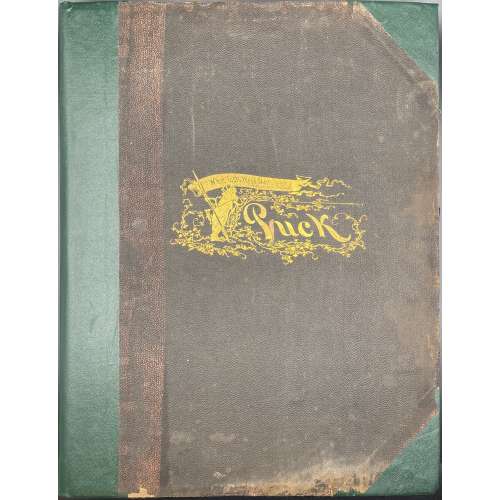 26 issues of American political humourous magazine published by Joseph Keppler (Austrian-American, 1838 – 1894) and Adolph Schwarzmann (German-American, 1838 – 1904) with caricatures by Frederick Burr Opper (American, 1857 – 1937); 35 x 27 cm, bound in faux shagreen with half green buckram backing, gilt vignette and lettering to front board: ‘What fools these Mortals be!” | MIDSUMMER NIGHT'S DREAM | PUCK ||
26 issues of American political humourous magazine published by Joseph Keppler (Austrian-American, 1838 – 1894) and Adolph Schwarzmann (German-American, 1838 – 1904) with caricatures by Frederick Burr Opper (American, 1857 – 1937); 35 x 27 cm, bound in faux shagreen with half green buckram backing, gilt vignette and lettering to front board: ‘What fools these Mortals be!” | MIDSUMMER NIGHT'S DREAM | PUCK || -
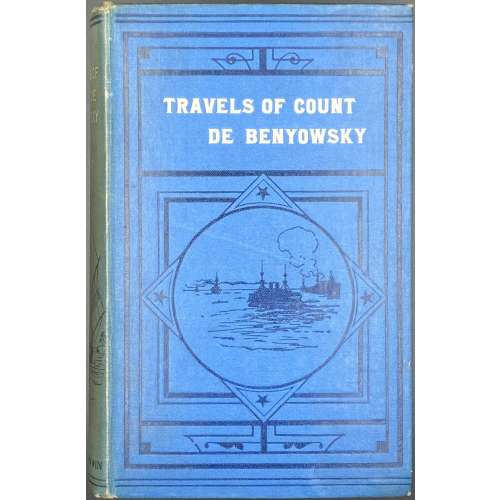 Hardcover volume in 8vo, 20.4 x 13.7 cm, blue cloth with black pictorial stamping and white embossed lettering to front cover and spine, spine sunned, head and tail frayed. Title-page: ❦❦❦ THE MEMOIRS AND | TRAVELS OF MAURITIUS | AUGUSTUS COUNT DE | BENYOWSKY ❦❦❦ | IN SIBERIA, KAMCHATKA, JAPAN, | THE LIUKIU ISLANDS AND FORMOSA | FROM THE TRANSLATION OF HIS | ORIGINAL MANUSCRIPT (1741–1771), | BY WILLIAM NICHOLSON, F.R.S., 1790 | EDITED BY CAPTAIN | PASFIELD OLIVER | ILLUSTRATED | LONDON: T. FISHER UNWIN, | PATERNOSTER SQUARE. MDCCCXCVIII || Collation/Pagination: [1]7 2-258; blue advertisement sheet laid in. [1, 2] – serial h.t. "The Adventure Series" / advert. THE ADVENTURE SERIES. Illustrated. Popular Re-issue, large cr. 8vo, 3s. 6d. 8 titles, [3, 4] – t.p. / blank, [5] 6-9 contents, [10] blank, [11, 12] missing, [13] 14-52 introduction, 53-399, [400] colophon: THE GRESHAM PRESS, | URWIN BROTHERS, | WORKING IN LONDON. Total number of leaves 199; 398 pages; one leaf of the first gathering missing (pp. 11/12 list of illustrations. No illustrations in this volume. Compared to another copy of the same edition, LIB-2701.2021, besides the binding: no list of illustrations, no illustrations, different colophon, different advertisement, slightly different h.t. Contributors: Publisher: T. Fisher Unwin (London); Thomas Fisher Unwin (British, 1848 – 1935). Author: Maurice Auguste count de Benyowsky [Мориц Август Бенёвский] (Polish-Slovak-Hungarian, 1746 –1786). Editor: Samuel Pasfield Oliver (British, 1838 – 1907). Translator: William Nicholson (British, 1753 – 1815). Originally published in 1790, in London (I have not seen it anywhere) and in Dublin by P. Wogan [etc.], and in 1791 in French, in Paris by Buisson; see LIB-2742.2021. For the 1904 edition, see LIB-2703.2021.
Hardcover volume in 8vo, 20.4 x 13.7 cm, blue cloth with black pictorial stamping and white embossed lettering to front cover and spine, spine sunned, head and tail frayed. Title-page: ❦❦❦ THE MEMOIRS AND | TRAVELS OF MAURITIUS | AUGUSTUS COUNT DE | BENYOWSKY ❦❦❦ | IN SIBERIA, KAMCHATKA, JAPAN, | THE LIUKIU ISLANDS AND FORMOSA | FROM THE TRANSLATION OF HIS | ORIGINAL MANUSCRIPT (1741–1771), | BY WILLIAM NICHOLSON, F.R.S., 1790 | EDITED BY CAPTAIN | PASFIELD OLIVER | ILLUSTRATED | LONDON: T. FISHER UNWIN, | PATERNOSTER SQUARE. MDCCCXCVIII || Collation/Pagination: [1]7 2-258; blue advertisement sheet laid in. [1, 2] – serial h.t. "The Adventure Series" / advert. THE ADVENTURE SERIES. Illustrated. Popular Re-issue, large cr. 8vo, 3s. 6d. 8 titles, [3, 4] – t.p. / blank, [5] 6-9 contents, [10] blank, [11, 12] missing, [13] 14-52 introduction, 53-399, [400] colophon: THE GRESHAM PRESS, | URWIN BROTHERS, | WORKING IN LONDON. Total number of leaves 199; 398 pages; one leaf of the first gathering missing (pp. 11/12 list of illustrations. No illustrations in this volume. Compared to another copy of the same edition, LIB-2701.2021, besides the binding: no list of illustrations, no illustrations, different colophon, different advertisement, slightly different h.t. Contributors: Publisher: T. Fisher Unwin (London); Thomas Fisher Unwin (British, 1848 – 1935). Author: Maurice Auguste count de Benyowsky [Мориц Август Бенёвский] (Polish-Slovak-Hungarian, 1746 –1786). Editor: Samuel Pasfield Oliver (British, 1838 – 1907). Translator: William Nicholson (British, 1753 – 1815). Originally published in 1790, in London (I have not seen it anywhere) and in Dublin by P. Wogan [etc.], and in 1791 in French, in Paris by Buisson; see LIB-2742.2021. For the 1904 edition, see LIB-2703.2021. -
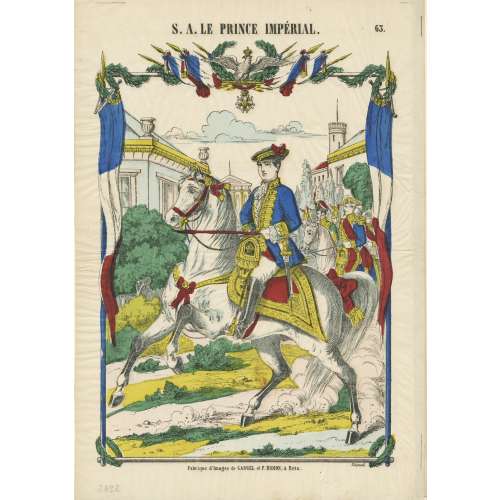 Hand-coloured woodcut on wove paper, 327 x 280 mm; black ink stamp “5265” to reverse, attached to the sheet 470 x 325 mm. Top centre: "S. A. LE PRINCE IMPÉRIAL.", right: "63." Image: equestiral portrait of Prince Impérial. Under the image, centre: "Fabrique d'Images de GANGEL et P. DIDION, à Metz." — "Déposé." Napoléon, Prince Imperial (Napoléon Eugène Louis Jean Joseph Bonaparte] (French, 1856 – 1879). Gangel et P. Didion (Metz); Paulin Didion (French, 1831 – 1879) – publisher/printer.
Hand-coloured woodcut on wove paper, 327 x 280 mm; black ink stamp “5265” to reverse, attached to the sheet 470 x 325 mm. Top centre: "S. A. LE PRINCE IMPÉRIAL.", right: "63." Image: equestiral portrait of Prince Impérial. Under the image, centre: "Fabrique d'Images de GANGEL et P. DIDION, à Metz." — "Déposé." Napoléon, Prince Imperial (Napoléon Eugène Louis Jean Joseph Bonaparte] (French, 1856 – 1879). Gangel et P. Didion (Metz); Paulin Didion (French, 1831 – 1879) – publisher/printer. -
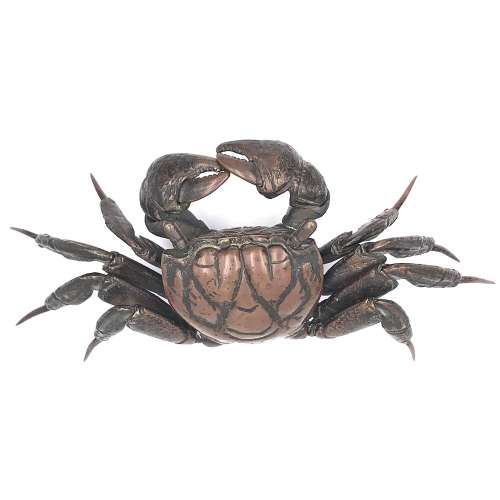 Jizai okimono bronze articulated model of a crab. Japan, Meiji period(1868-1912). Size: Body: 6.5 x 6 cm. Total: 23 x 11 cm. Weight: 762 g
Jizai okimono bronze articulated model of a crab. Japan, Meiji period(1868-1912). Size: Body: 6.5 x 6 cm. Total: 23 x 11 cm. Weight: 762 g -
 Kitagawa Utamaro. Illustration from the book Ehon koi no Onamaki. Cited at Hayashi Yoshikazu's 20-volume set Edo makura-e shi shusei: Kitagawa Utamaro. Size: Chuban (25.5 x 18.5 cm), two book pages glued together.
Kitagawa Utamaro. Illustration from the book Ehon koi no Onamaki. Cited at Hayashi Yoshikazu's 20-volume set Edo makura-e shi shusei: Kitagawa Utamaro. Size: Chuban (25.5 x 18.5 cm), two book pages glued together. -
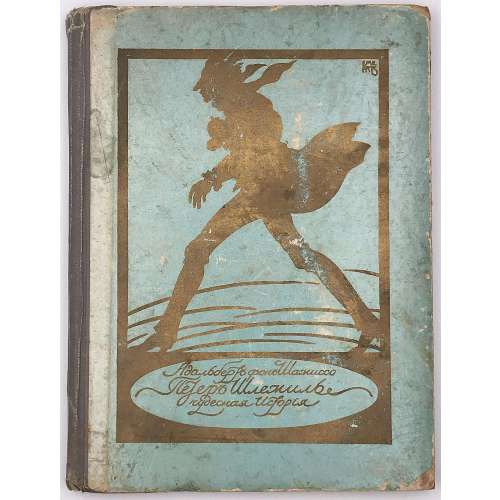
Шамиссо, Адальбертъ фонъ. Петеръ Шлемиль. Чудесная исторiя. Пер. П.Потемкина. Рис., виньетки и перепет Эмиля Преторiуса по 1-му нѣм. изд. 1814 г. — СПб.: Книгоиздательство "Пантеонъ", 1910. — 107 стр. Отпечатано в типографии акц. о-ва типографск. дела в СПБ (Герольд), 7 рота, 26.
Cardboard binding, 8vo, 20 x 15 cm. Russian translation of Adelbert von Chamisso book Peter Schlemihl, from the German by Peter Potemkine. With illustrations from 1814 original German first edition by Emil Preetorius. [SV: the latest statement seems strange as Emil Preetorius lived from 1883 to 1973]. -
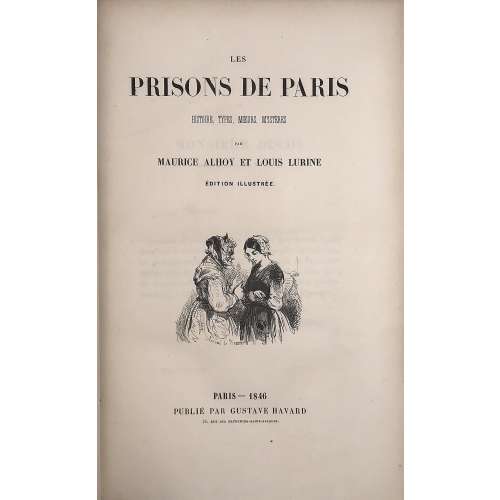 Exterior: 4to, 27.3 x 18 cm, quarter black morocco over marbled boards, double gilt fillet border, spine with raised bands, compartments framed in gilt with gilt fleurons, black label lettered in gilt; marbled endpapers. Inscription to half-title in the bottom: no 411. Bookplate to front pastedown. Title-page: LES | PRISONS DE PARIS | HISTOIRE, TYPES, MŒURS, MYSTÈRES | PAR | MAURICE ALHOY ET LOUIS LURINE | ÉDITION ILLUSTRÉE. | {vignette} | PARIS — 1846 | PUBLIÉ PAR GUSTAVE HAVARD | 24, RUE DES MATHURINS-SAINT-JACQUES. || Printer: Lacrampe et Comp. Collation: 4to; π2 a4 1-684 χ2; total 280 leaves and 34 leaves of plates. Pagination: first and last leaves blank; [2 -h.t./imprint.] [2 - t.p./blank] [2 dedication/blank] [i intro] ii-vi, [1] 2-544 [2 - list of plates/advert.] [2 - contents/blank]; total 560 pages, plus 34 wood-engraved plates, incl. a frontispiece by Laisne after Bertall, and numerous in-text woodcuts. Provenance: Bookplate of Selim Hippolyte Ansart (French, 1829 – 1897), commissar of police in the Second Empire and shortly after (chef de la police municipaie ; chevalier du 13 août 1867; vingt-trois ans de service effectif). Authors: Philadelphe-Maurice Alhoy (French, 1802 – 1856) Louis Lurine (French, 1812 – 1860) Artists: Bertall [ Bertal; Charles Albert d’Arnoux (French, 1820 – 1882) Jules [Jean-Baptiste] David (French, 1808–1892) Charles-François Pinot (French, 1817 – 1879) Eustache Lorsay [French, Eugène Lampsonius] (1822 – 1871) Pierre Édouard Frère (French, 1819 – 1886) Charles-Édouard de Beaumont (French, 1819 – 1888) Engravers Laisné Adèle / Aglaé / Alfred (French, fl. 1835 – 1868) Louis Dujardin (French, 1808 – 1859) François Rouget (Belgian, c. 1825 – ?) Janet-Lange [Ange-Louis Janet] (French, 1815 – 1872) Jacques Adrien Lavieille (French, 1818 – 1862) Timms (French, fl. c. 1839 – 1865) Félix Leblanc (French, 1823 – ?) Émile Montigneul (French, fl. 1840 – 1850)
Exterior: 4to, 27.3 x 18 cm, quarter black morocco over marbled boards, double gilt fillet border, spine with raised bands, compartments framed in gilt with gilt fleurons, black label lettered in gilt; marbled endpapers. Inscription to half-title in the bottom: no 411. Bookplate to front pastedown. Title-page: LES | PRISONS DE PARIS | HISTOIRE, TYPES, MŒURS, MYSTÈRES | PAR | MAURICE ALHOY ET LOUIS LURINE | ÉDITION ILLUSTRÉE. | {vignette} | PARIS — 1846 | PUBLIÉ PAR GUSTAVE HAVARD | 24, RUE DES MATHURINS-SAINT-JACQUES. || Printer: Lacrampe et Comp. Collation: 4to; π2 a4 1-684 χ2; total 280 leaves and 34 leaves of plates. Pagination: first and last leaves blank; [2 -h.t./imprint.] [2 - t.p./blank] [2 dedication/blank] [i intro] ii-vi, [1] 2-544 [2 - list of plates/advert.] [2 - contents/blank]; total 560 pages, plus 34 wood-engraved plates, incl. a frontispiece by Laisne after Bertall, and numerous in-text woodcuts. Provenance: Bookplate of Selim Hippolyte Ansart (French, 1829 – 1897), commissar of police in the Second Empire and shortly after (chef de la police municipaie ; chevalier du 13 août 1867; vingt-trois ans de service effectif). Authors: Philadelphe-Maurice Alhoy (French, 1802 – 1856) Louis Lurine (French, 1812 – 1860) Artists: Bertall [ Bertal; Charles Albert d’Arnoux (French, 1820 – 1882) Jules [Jean-Baptiste] David (French, 1808–1892) Charles-François Pinot (French, 1817 – 1879) Eustache Lorsay [French, Eugène Lampsonius] (1822 – 1871) Pierre Édouard Frère (French, 1819 – 1886) Charles-Édouard de Beaumont (French, 1819 – 1888) Engravers Laisné Adèle / Aglaé / Alfred (French, fl. 1835 – 1868) Louis Dujardin (French, 1808 – 1859) François Rouget (Belgian, c. 1825 – ?) Janet-Lange [Ange-Louis Janet] (French, 1815 – 1872) Jacques Adrien Lavieille (French, 1818 – 1862) Timms (French, fl. c. 1839 – 1865) Félix Leblanc (French, 1823 – ?) Émile Montigneul (French, fl. 1840 – 1850) -
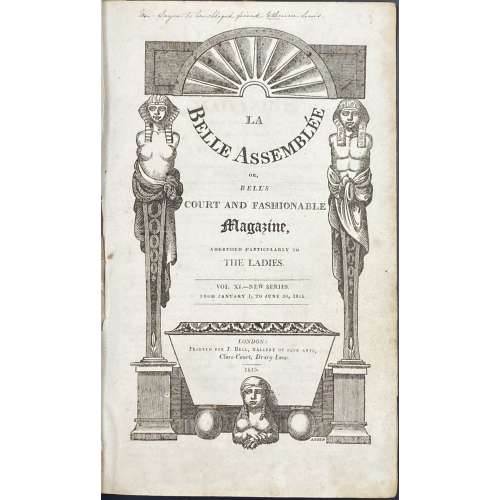 Title: LA | BELLE ASSEMBLÉE | OR, | BELL'S | COURT AND FASHIONABLE | MAGAZINE, | ADDRESSED PARTICULARLY TO | THE LADIES. | VOL. XI.—NEW SERIES. | FROM JANUARY 1, TO JUNE 30, 1815. | LONDON: | Printed for J. BELL, GALLERY OF FINE ARTS, | Clare-Court, Drury-Lane. | 1815. || Pagination: [2] – 11th volume wood-engraved pictorial title page, [1, 2] – January faux-title and table of content, [3] 4-284 [2] – index to 11th vol. Notes: February f.t. not paginated, but within the collation; the last page of the index at the very end paginated [iii]/iv, so pages i/ii missing (the gathering Nn lacking one sheet) Collation: 4to; π1 A-Mm4 Nn3, 28 plates extraneous to collation (lacking 2 plates). Binding: Half brown morocco over marbled boards, flat spine, compartments gilt-ruled with double-fillet and gilt-lettered. Contents: Jan: pp. 1-48, 5 plates. Feb: pp. 51-96, 5 plates. Mar: pp. 97-144, 5 plates. Apr: pp. 145-192, 5 plates. May: pp. 193-240, 5 plates. Jun: pp. 241-284, 3 plates (lacking 2 colour prints). Fashion plates, two per issue, are hand-coloured copperplate engravings, unsigned. Stipple engraved portraits, one per issue as frontispiece: (1) Actress Catherine Stephens, Countess of Essex (British, 1794 – 1882) by James Hopwood the Elder [James Hopwood Senior] (British, c. 1740s/50s – 1819) after Sir George Hayter (British, 1792 – 1871); (2) Madame de Talleyrand, Princesse De Bénévent (Danish-French, 1761– 1834), unsigned, but can be attributed to François Gérard (French, 1770 – 1837); (3) Actress Miss Sarah Booth (1793 – 30 December 1867), unsigned; (4) Group portrait of the French Royal family (Louis XVI, Louis XVII, Marie Antoinette, Madam Elizabeth, Louis Antoine de Bourbon, Duke d'Enghien, and Marie Thérèse Louise of Savoy, Princesse de Lamballe), unsigned, (5) Actress, Miss Sarah Blanche Matthews (b.1794) by Thomas Burke (Irish, 1749 – 1815) after George Hayter. The sixth print, in the March issue, is a lithographic portrait of Napoléon Bonaparte (French, 1769 – 1821), unsigned.
Title: LA | BELLE ASSEMBLÉE | OR, | BELL'S | COURT AND FASHIONABLE | MAGAZINE, | ADDRESSED PARTICULARLY TO | THE LADIES. | VOL. XI.—NEW SERIES. | FROM JANUARY 1, TO JUNE 30, 1815. | LONDON: | Printed for J. BELL, GALLERY OF FINE ARTS, | Clare-Court, Drury-Lane. | 1815. || Pagination: [2] – 11th volume wood-engraved pictorial title page, [1, 2] – January faux-title and table of content, [3] 4-284 [2] – index to 11th vol. Notes: February f.t. not paginated, but within the collation; the last page of the index at the very end paginated [iii]/iv, so pages i/ii missing (the gathering Nn lacking one sheet) Collation: 4to; π1 A-Mm4 Nn3, 28 plates extraneous to collation (lacking 2 plates). Binding: Half brown morocco over marbled boards, flat spine, compartments gilt-ruled with double-fillet and gilt-lettered. Contents: Jan: pp. 1-48, 5 plates. Feb: pp. 51-96, 5 plates. Mar: pp. 97-144, 5 plates. Apr: pp. 145-192, 5 plates. May: pp. 193-240, 5 plates. Jun: pp. 241-284, 3 plates (lacking 2 colour prints). Fashion plates, two per issue, are hand-coloured copperplate engravings, unsigned. Stipple engraved portraits, one per issue as frontispiece: (1) Actress Catherine Stephens, Countess of Essex (British, 1794 – 1882) by James Hopwood the Elder [James Hopwood Senior] (British, c. 1740s/50s – 1819) after Sir George Hayter (British, 1792 – 1871); (2) Madame de Talleyrand, Princesse De Bénévent (Danish-French, 1761– 1834), unsigned, but can be attributed to François Gérard (French, 1770 – 1837); (3) Actress Miss Sarah Booth (1793 – 30 December 1867), unsigned; (4) Group portrait of the French Royal family (Louis XVI, Louis XVII, Marie Antoinette, Madam Elizabeth, Louis Antoine de Bourbon, Duke d'Enghien, and Marie Thérèse Louise of Savoy, Princesse de Lamballe), unsigned, (5) Actress, Miss Sarah Blanche Matthews (b.1794) by Thomas Burke (Irish, 1749 – 1815) after George Hayter. The sixth print, in the March issue, is a lithographic portrait of Napoléon Bonaparte (French, 1769 – 1821), unsigned. -
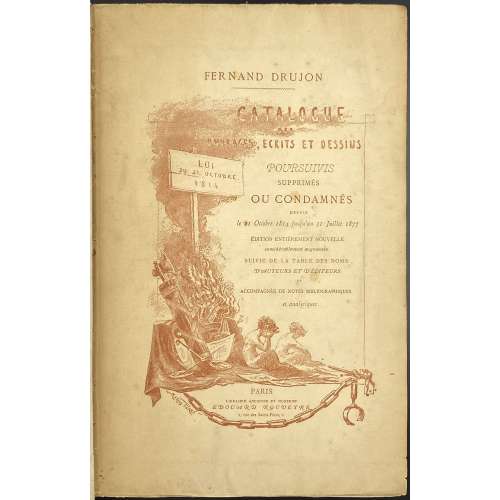 Title page: CATALOGUE | DES | OUVRAGES, ÉCRITS | ET DESSINS | DE TOUTE NATURE | POURSUIVIS, SUPPRIMÉS OU CONDAMNÉS | DEPUIS LE 21 OCTOBRE 1814 JUSQU'AU 31 JUILLET 1877 | Edition entièrement nouvelle, considérablement augmentée | SUIVIE DE LA TABLE DES NOMS D’AUTEURS ET D’ÉDITEURS | ET ACCOMPAGNÉE DE NOTES BIBLIOGRAPHIQUES ET ANALYTIQUES | PAR | FERNAND DRUJON | {publisher’s device} | PARIS | LIBRAIRIE ANCIENNE ET MODERNE | ÉDOUARD ROUVEYRE | 1, RUE DES SAINTS-PÈRES, 1 | 1879 || Pagination: [2] [i-v] vi-xxxvii [xxxviii blank] [1] 2-430 [2] 1-16, total number of pages 2+38+430+2+16=488. Collation: 8vo; π4 i-ii8 1-258 26-294 ω8, total number of leaves 4+(2x8)+(25x8)+(4x4)+8=244; 2 binder’s blank leaves before the front wrapper, 2 blanks after the wrapper, blank / avis important, h.t. with gift inscription from publisher to Anger / limitation, t.p. / blank, [text], 17 leaves of advert., 2 blanks before back wrapper, 1 binder’s blank after. Binding: 28.3 x 19 cm, tree-quarter beige buckram over marbled boards, spine: brown leather label with gilt double fillet top and bottom, gilt lettering, stamped in gilt with a lily and a year of publishing, gilt double-fillet to tail; publisher’s wrappers bound in. Bookplate with motto “AGE DICANT” to front pastedown. Gift inscription: "À mon ami Anger | Hommage de me bien dévoué | Édouard Rouveyre". Possibly Pierre Anger (1854-19..).Contributors: Drujon, Fernand (French, 1845 – 1912) Rouveyre, Édouard (French, 1849 – 1930)Edition: 1st edition, this copy is from an unnumbered print run. Despite the note "Edition entièrement nouvelle, considérablement augmentée" this is obviously the 1st edition.
Title page: CATALOGUE | DES | OUVRAGES, ÉCRITS | ET DESSINS | DE TOUTE NATURE | POURSUIVIS, SUPPRIMÉS OU CONDAMNÉS | DEPUIS LE 21 OCTOBRE 1814 JUSQU'AU 31 JUILLET 1877 | Edition entièrement nouvelle, considérablement augmentée | SUIVIE DE LA TABLE DES NOMS D’AUTEURS ET D’ÉDITEURS | ET ACCOMPAGNÉE DE NOTES BIBLIOGRAPHIQUES ET ANALYTIQUES | PAR | FERNAND DRUJON | {publisher’s device} | PARIS | LIBRAIRIE ANCIENNE ET MODERNE | ÉDOUARD ROUVEYRE | 1, RUE DES SAINTS-PÈRES, 1 | 1879 || Pagination: [2] [i-v] vi-xxxvii [xxxviii blank] [1] 2-430 [2] 1-16, total number of pages 2+38+430+2+16=488. Collation: 8vo; π4 i-ii8 1-258 26-294 ω8, total number of leaves 4+(2x8)+(25x8)+(4x4)+8=244; 2 binder’s blank leaves before the front wrapper, 2 blanks after the wrapper, blank / avis important, h.t. with gift inscription from publisher to Anger / limitation, t.p. / blank, [text], 17 leaves of advert., 2 blanks before back wrapper, 1 binder’s blank after. Binding: 28.3 x 19 cm, tree-quarter beige buckram over marbled boards, spine: brown leather label with gilt double fillet top and bottom, gilt lettering, stamped in gilt with a lily and a year of publishing, gilt double-fillet to tail; publisher’s wrappers bound in. Bookplate with motto “AGE DICANT” to front pastedown. Gift inscription: "À mon ami Anger | Hommage de me bien dévoué | Édouard Rouveyre". Possibly Pierre Anger (1854-19..).Contributors: Drujon, Fernand (French, 1845 – 1912) Rouveyre, Édouard (French, 1849 – 1930)Edition: 1st edition, this copy is from an unnumbered print run. Despite the note "Edition entièrement nouvelle, considérablement augmentée" this is obviously the 1st edition. -

Lithography on paper by Charles Fichot (French, 1817 – 1903), published in a supplement to the Illustrated London News of July 6, 1867.
The construction on the foreground is the International Exposition of 1867 (Exposition universelle d'art et d'industrie de 1867). Dimensions: Sheet: 130 x 58 cm; Image: 118 x 43 cm. -
 Title: Ninth lunar month [菊月] (Kikuzuki no zu); Series: Fashionable Twelve Months (Imayo juni-kagetsu). Another version of translation: Modern Beauties of Twelve Months. Artist: Utagawa Toyokuni I [歌川豊国] (1769–1825). Pubisher: Ibaya Senzaburō [伊場屋仙三郎] (Japanese, 1815 – 1869), seal: Dansendō [伊場仙]. Signed: Toyokuni ga and sealed with toshidama. Date-kiwame seal: Ushi (ox), Bunsei 5 (1822). Size: double-sheet uncut fan print ( aiban uchiwa-e), 219 x 295 mm.
Title: Ninth lunar month [菊月] (Kikuzuki no zu); Series: Fashionable Twelve Months (Imayo juni-kagetsu). Another version of translation: Modern Beauties of Twelve Months. Artist: Utagawa Toyokuni I [歌川豊国] (1769–1825). Pubisher: Ibaya Senzaburō [伊場屋仙三郎] (Japanese, 1815 – 1869), seal: Dansendō [伊場仙]. Signed: Toyokuni ga and sealed with toshidama. Date-kiwame seal: Ushi (ox), Bunsei 5 (1822). Size: double-sheet uncut fan print ( aiban uchiwa-e), 219 x 295 mm.

-
 Artist: Utagawa Kuniyoshi [歌川 國芳] (Japanese, 1798 – 1861). Publisher: Ibaya Senzaburō [伊場屋仙三郎] (Japanese, c. 1815 – 1869). Date-aratame seal: 1827 (Bunsei 10). Inscription: Ohan [おはん], Chōemon [長右衛門] | Dainingyō [大人形] | Yoshida Senshi [吉田千四)] | unclear (work in progress). Sam. L. Leiter describes the play in his Kabuki Encyclopedia (1979) p. 183, and Japanese traditional theatre (2014), p. 252 as "Love Suicide of Ohan and Choemon at the Katsura River" (Katsuragawa Renri no Shigarami) [桂川連理柵], a two-act play by Suga Sensuke [菅専助] (ca. 1728 – 1791) written in 1776 for the puppet theatre jūruri and adopted for Osaka kabuki in 1777. Yoshida Senshi, a.k.a. Yoshida Bunzaburo III was a Japanese puppeteer of a Yoshida lineage. The line was established by Yoshida Bunzaburō I [吉田文三郎] (Japanese, fl. 1717 – 1760), who was one of the greatest in the history of Bunraku [人形浄瑠璃] (ningyō jōruri) and who around 1734 introduced the three-man puppet manipulation system. A portrait of Yoshida Senshi, who died in 1829, can be found in the Kunisada's triptych at Jordan Schnitzer Museum of Art, ID Number 2016:37.2.).
Artist: Utagawa Kuniyoshi [歌川 國芳] (Japanese, 1798 – 1861). Publisher: Ibaya Senzaburō [伊場屋仙三郎] (Japanese, c. 1815 – 1869). Date-aratame seal: 1827 (Bunsei 10). Inscription: Ohan [おはん], Chōemon [長右衛門] | Dainingyō [大人形] | Yoshida Senshi [吉田千四)] | unclear (work in progress). Sam. L. Leiter describes the play in his Kabuki Encyclopedia (1979) p. 183, and Japanese traditional theatre (2014), p. 252 as "Love Suicide of Ohan and Choemon at the Katsura River" (Katsuragawa Renri no Shigarami) [桂川連理柵], a two-act play by Suga Sensuke [菅専助] (ca. 1728 – 1791) written in 1776 for the puppet theatre jūruri and adopted for Osaka kabuki in 1777. Yoshida Senshi, a.k.a. Yoshida Bunzaburo III was a Japanese puppeteer of a Yoshida lineage. The line was established by Yoshida Bunzaburō I [吉田文三郎] (Japanese, fl. 1717 – 1760), who was one of the greatest in the history of Bunraku [人形浄瑠璃] (ningyō jōruri) and who around 1734 introduced the three-man puppet manipulation system. A portrait of Yoshida Senshi, who died in 1829, can be found in the Kunisada's triptych at Jordan Schnitzer Museum of Art, ID Number 2016:37.2.). The design on our fan print looks very much like the one of Toyokuni I at MFA (Houston): OBJECT NUMBER 2006.378. "Seki Sanjuro as Obiya Choemon and Ichikawa Denzo as Ohan of the Shinonoya from the Kabuki Drama Katsuragawa renri no shigarami (Love Suicide of Ohan and Choemon at the Katsura River)", according to MFA-H published by someone Tsuruya in c. 1810 (though the publisher's seal is Suzuki Ihei [鈴木伊兵衛] (seal name Suzui [鈴伊]), Marks 01-028 | 502; the censor's seal is gyōji, date 1811-14).
The design on our fan print looks very much like the one of Toyokuni I at MFA (Houston): OBJECT NUMBER 2006.378. "Seki Sanjuro as Obiya Choemon and Ichikawa Denzo as Ohan of the Shinonoya from the Kabuki Drama Katsuragawa renri no shigarami (Love Suicide of Ohan and Choemon at the Katsura River)", according to MFA-H published by someone Tsuruya in c. 1810 (though the publisher's seal is Suzuki Ihei [鈴木伊兵衛] (seal name Suzui [鈴伊]), Marks 01-028 | 502; the censor's seal is gyōji, date 1811-14).
 Interestingly enough, the description provided by Kuniyoshi Project is this "Actors: Onoe Kikugorô III as Shinanoya Ohan (おはん, female) and Ichikawa Ebizô V as Obiya Choemon (長右衛門, male). Play: Go chumon shusu no Obiya (御注文繻子帯屋). Date: 3rd month of 1840. Theater: Kawarasaki. Publisher: Iba-ya Sensaburô".
The play Go chumon shusu no Obiya was indeed staged at Kawarazaki theatre in 1840 (Tenpō 11), 3rd month; Ichikawa Ebizō V was indeed playing Obiya Choemon but Onoe Kikugorō III had the role of Kataoka Kōzaemon, not of Ohan, as can be seen on Kunisada's diptych at MFA (Boston): ACCESSION NUMBER 11.40671a-b.
Interestingly enough, the description provided by Kuniyoshi Project is this "Actors: Onoe Kikugorô III as Shinanoya Ohan (おはん, female) and Ichikawa Ebizô V as Obiya Choemon (長右衛門, male). Play: Go chumon shusu no Obiya (御注文繻子帯屋). Date: 3rd month of 1840. Theater: Kawarasaki. Publisher: Iba-ya Sensaburô".
The play Go chumon shusu no Obiya was indeed staged at Kawarazaki theatre in 1840 (Tenpō 11), 3rd month; Ichikawa Ebizō V was indeed playing Obiya Choemon but Onoe Kikugorō III had the role of Kataoka Kōzaemon, not of Ohan, as can be seen on Kunisada's diptych at MFA (Boston): ACCESSION NUMBER 11.40671a-b.

Actors Ichikawa Ebizô V as Obiya Chôemon (R) and Onoe Kikugorô III as Kataoka Kôzaemon (L)
-
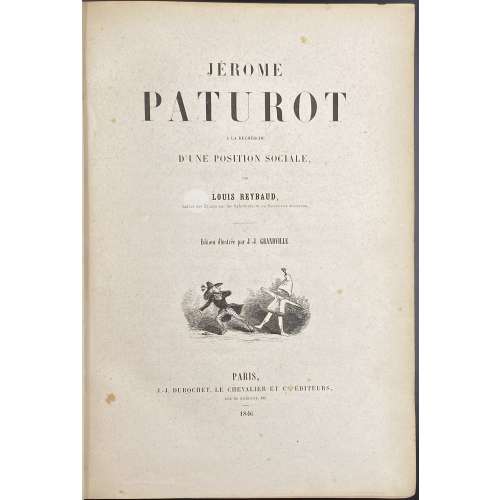 4to volume, ‘cartonnage percaline romantique’, 27.5 x 19.5 cm, green cloth with gilt fillet border and fictional coat of arms to front, border and fleuron to back, gilt and embossed vignette to spine, yellow endpapers, all edges gilt, 32 plates, incl. frontispiece, with tissue guards, and numerous in-text woodcuts after J.-J. Grandville by various engravers, mostly by Best, Leloir, Hotelin et Régnier group. Page 102 is numbered correctly. Title-page: JÉROME | PATUROT | A LA RECHERCHE | D'UNE POSITION SOCIALE | PAR | LOUIS REYBAUD, | Auteur des Études sur les Reformateurs ou Socialistes modernes. | — | Édition illustrée par J.-J. Grandville. | {vignette} | PARIS, | J.-J. DUBOCHET, LE CHEVALIER ET Cie, ÉDITEURS, | RUE DE RICHELIEU, 60. | – | 1846 || Collation: π4 1-574 582; total 234 leaves plus 32 wood-engraved plates extraneous to collation. Pagination: [8] [1] 2-460; total 468 pages, ils. Catalogue raisonné: L. Carteret 516; Ray 197 (pp. 277-8); Brivois: 350-1. Contributors: Louis Reybaud [Jérôme Paturot] (French, 1799 – 1879) – author. J.-J. Grandville [Isidore-Adolphe Gèrard] (French, 1803 – 1847) – artist. Schneider et Legrand (Paris) – printer. J.-J. Dubochet, Le Chevalier et Cie – publsiher. Engravers: Lucjan Stypulkowski (Polish, 1806 – 1849) Best, Leloir, Hotelin et Régnier Jean Baptiste Best (French, 1808 – 1879) or Adolphe Best (French, 1808 – 1860) Isidore Leloir (French, 1806 – 1851) Laurent Éloi Hotelin (French, 1821 – 1894) Eugène Laurent Isidore Régnier (?)
4to volume, ‘cartonnage percaline romantique’, 27.5 x 19.5 cm, green cloth with gilt fillet border and fictional coat of arms to front, border and fleuron to back, gilt and embossed vignette to spine, yellow endpapers, all edges gilt, 32 plates, incl. frontispiece, with tissue guards, and numerous in-text woodcuts after J.-J. Grandville by various engravers, mostly by Best, Leloir, Hotelin et Régnier group. Page 102 is numbered correctly. Title-page: JÉROME | PATUROT | A LA RECHERCHE | D'UNE POSITION SOCIALE | PAR | LOUIS REYBAUD, | Auteur des Études sur les Reformateurs ou Socialistes modernes. | — | Édition illustrée par J.-J. Grandville. | {vignette} | PARIS, | J.-J. DUBOCHET, LE CHEVALIER ET Cie, ÉDITEURS, | RUE DE RICHELIEU, 60. | – | 1846 || Collation: π4 1-574 582; total 234 leaves plus 32 wood-engraved plates extraneous to collation. Pagination: [8] [1] 2-460; total 468 pages, ils. Catalogue raisonné: L. Carteret 516; Ray 197 (pp. 277-8); Brivois: 350-1. Contributors: Louis Reybaud [Jérôme Paturot] (French, 1799 – 1879) – author. J.-J. Grandville [Isidore-Adolphe Gèrard] (French, 1803 – 1847) – artist. Schneider et Legrand (Paris) – printer. J.-J. Dubochet, Le Chevalier et Cie – publsiher. Engravers: Lucjan Stypulkowski (Polish, 1806 – 1849) Best, Leloir, Hotelin et Régnier Jean Baptiste Best (French, 1808 – 1879) or Adolphe Best (French, 1808 – 1860) Isidore Leloir (French, 1806 – 1851) Laurent Éloi Hotelin (French, 1821 – 1894) Eugène Laurent Isidore Régnier (?)






